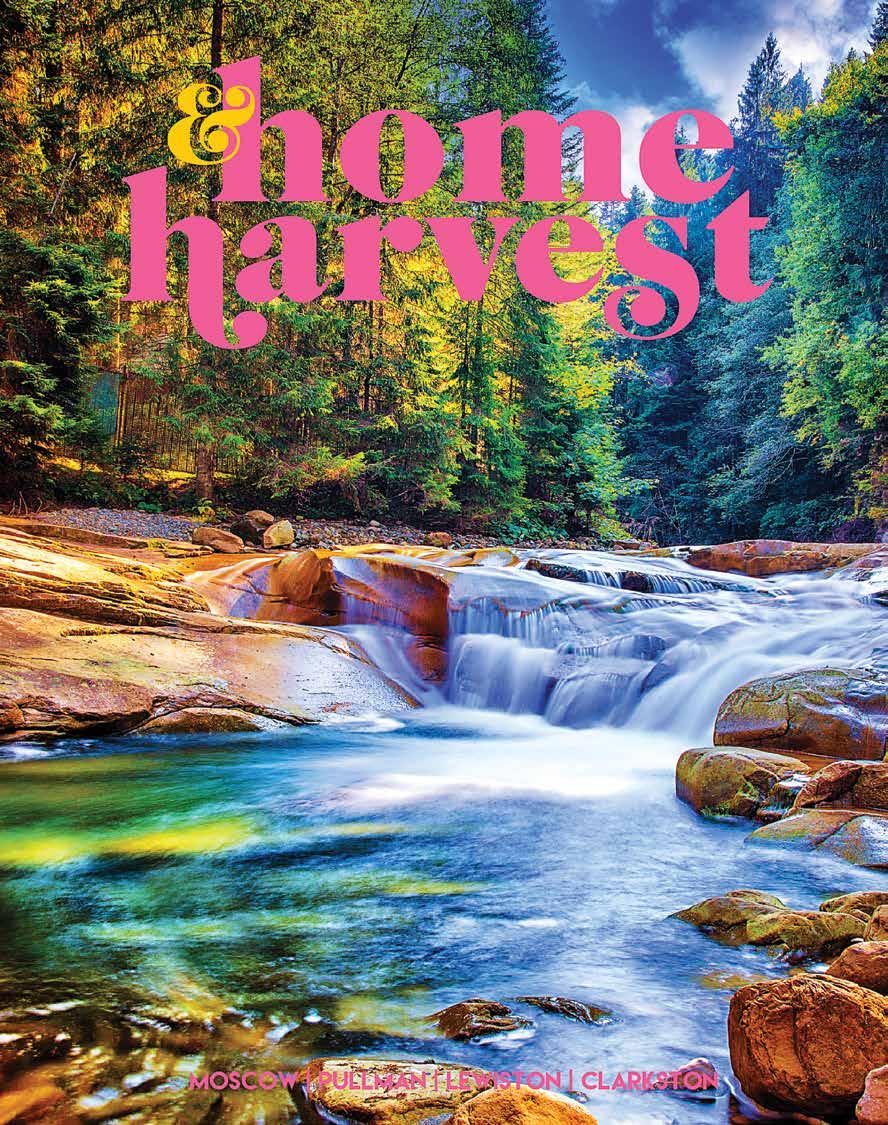




I’ve been inspired by the idea that the new year isn’t the time to set goals- that we should instead keep hibernating until spring- the time when things blossom, become new again, and grow. I love that nature is constantly trying to speak to us and that even the shortest periods of time appreciating it creates endless insight to living a better life. For me, I’ve been thinking a lot about water. A humble crick, creek or beautiful stream that seems to grow stronger as it continues to shake off it’s own frozen waves. Aren’t we all like that in the spring? And it got me thinking about something I’m not too familiar with- the state of flow.
I’ve been learning what happens when you let go and I’m excitedly humbled to share with you that it’s only when you truly let go that the blessings come flowing in. I’ve written about receiving before, but flow is something different, something much easier in theory but harder for us humans. It’s the art of having faith and trust that things will work out- that everything is happening for the best. I don’t know about you but these last few years have put my hope to the test. I’ve come to learn something so powerful- you can’t hold hope in one hand and control in the other. You must learn to be in the flow of life.
Recently I’ve been practicing this at work, home, and most importantly, when I speak to myself. It was flow when Tony and I decided to only own one business. It was flow when I gave myself permission to get rid of a ton of clutter. It’s flow whenever I give myself permission to get creative with this magazine. Worrying about every outcome, every judgment, every detail blocks the very gift of life. When I’m experiencing anxiety, I know that at any given time I can focus on my fear or just let it sit there- and feel it. Give it space. Let it flow. I’m continually shocked by now quickly it naturally passes. In the meantime, I fill my thoughts with support, positivity and kindness. It is my goal to no longer control my thoughts or anxiety but simply to allow it all.
I share this with you because I can’t help but notice that we’re all a little tired and unsure. Some of us are downright scared and overwhelmed with everything going on in the world. There’s no simple sentence or thought to make it go away but I can tell you this- allow the good to come in so you CAN keep going. I know many of you have forgotten just how much you mean to the world around you, and even you haven’t discovered just how special you are. Stop holding on to everything that isn’t working out for you and let it all flow- give yourself time to experience the true meaning of spring.
I hope you know that you are loveable, kind, special and unique. You are seen. You’re never too old to have a new dream, get out of hibernation and start a new direction. I am proof that you can do it. Even if you’re scared, burned out and lost. Let yourself be like the water on this cover: sometimes smooth, sometimes rushing, still and reflective in places, but at all times, endlessly, beautifully, flowing.
Happy Spring!
 Heather Niccoli Editor-In-Chief Home&Harvest Magazine
Heather Niccoli Editor-In-Chief Home&Harvest Magazine

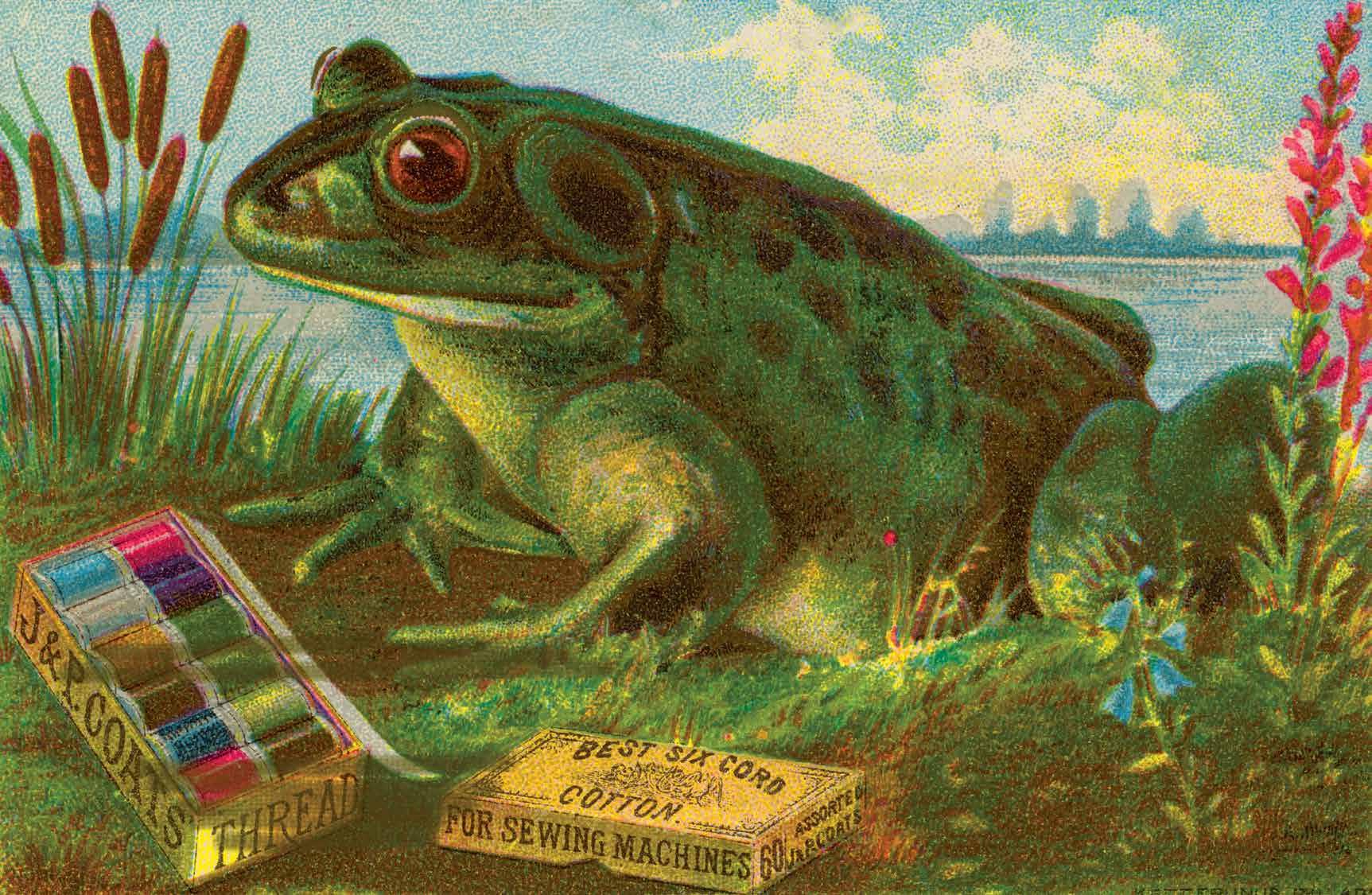



Wind, Rain, Mud, Sun 8 Resilience 12 Flank to Flame 20 Italian Easter Bread 24 Peanut Butter Banana Pie 26 Chocolate Cake + Ermine Frosting 28 Homemade Mayo 30 Buffalo Chicken Dip 32 Hummingbird Cake 34 Feast of Life 36 Spring with a Farm 42 Flora & Fauna 48 A Reading For You 54 Up, Up & Away 56 New Nest in Town 64 A Home For Kaya 72 The Oh, Otis Shenanigans 74 CONTENTS

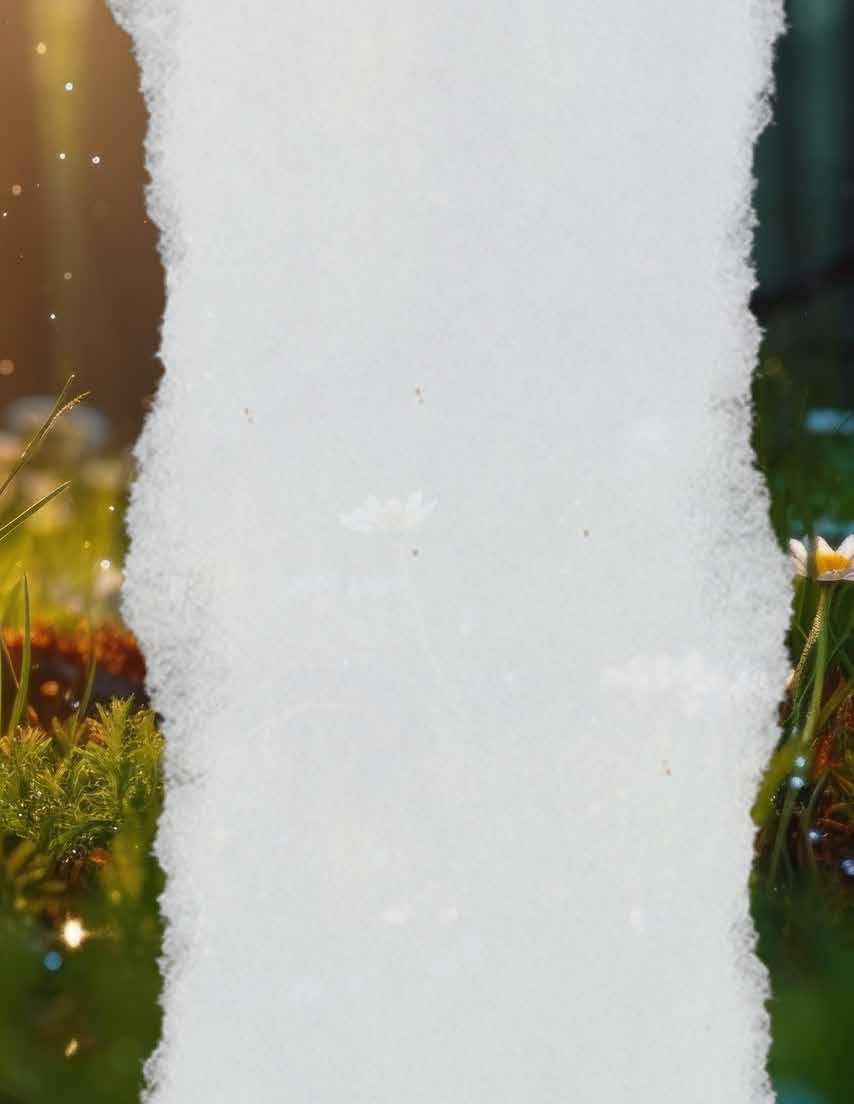
ANNIE GEBEL
Spring! It’s almost an onomatopoeia - a word that sounds like it’s meaning. When I say it, it lifts some of the dreary away and I immediately picture the gray landscape beginning to sprout some color. It’s a season of lightness and anticipation. It’s when we take down storm windows, throw open shutters, and let the fresh air come back into our homes. It’s when kids splash in puddles, baby animals appear, and nails get dirty with gardening. Where winter is a season for rest and preparation, spring is a season of doing, being, and growing - and you can almost hear that all in the one little word. Spring.
Now, I don’t know about you, but I love spring. As I fell in love with the other seasons more, I wasn’t sure if spring would remain a favorite, but it has, although maybe for more complex reasons. As I’ve deepened so has my adoration of this time of year. I still love the first daffodils and tulips I see bringing color to people’s yards. I still enjoy the grass turning green again. I don’t think I could ever not love the smell of rain, yet there’s more to this season of doing, being, and growing. I now see it as a season of change.
I’ve always enjoyed change, even the stuff that’s uncomfortable, because I hold the belief that change and growth go hand in hand and that excites me! Maybe that’s a part of spring that’s always spoken to my heart, even if I didn’t understand it, but now I do and think of all the transitions that take place during this time of the year with renewed awe. I also now see all the ways spring offers help as we move through changes that aren’t always easy, desired, or fun. And, that, my friends, is the point I’m finally getting to!
Nature and the seasons have much to teach us if we only open up to their lessons, and a great deal of what we can learn is about change. There’s a saying that involves change being a constant in life because it’s true and we witness it in nature and the way it moves through the seasons of the year and the way the life-death-rebirth cycle is embraced by plants and animals alike. And, today, I’m going to bring one more powerhouse helper into the mix to help us really process and work through transitions - the elements. Spring has them all! (Technically, all the seasons do, in some fashion, but I’m only going to talk about Spring, so bear with me.)
You’ve likely heard that April showers bring May flowers, but there’s more to that little rhyme and it includes March winds! Who knew!? Well, now we all do. It might not come as a huge surprise, though, if you think about it, because the two often come hand in hand with at the very least a stiff breeze bringing in the clouds that hold the rain. How can these things help us with change, though? Release. It’s one of the hardest parts of change, I think. Definitely one of the scariest. Releasing what we know in exchange for possibility and opportunity all boils down to lack of control and trusting in some outcome that we aren’t familiar with. Human nature, in these instances, is to grip more tightly, I think. Yet that can have an unintended consequence of making the transition even harder and sometimes more traumatic. So, to help me release emotionally, I often turn to air and water. Maybe you can give it a try too.
To let the wind help me, one of my favorite practices is to face the wind with my arms raised up and outward, welcoming it. And as I stand there, feeling it push against me, I ask it to blow away whatever I’m holding that I no longer need to. Sometimes I can name things. “Please take my bitterness over having to pick up extra hours.”
_ _
by


Other times I simply ask to feel lighter as the heaviness is lifted and taken again on the breeze. While I do this I might let my mind go blank or wander where it wants or I might intentionally picture the wind clearing last year’s fallen leaves from the ground and noticing the green sprouts that have poked through the dirt. Honestly, with this practice, and all the others I’m sharing today, there’s not a right or wrong way to do the thing - it’s more about what your intention is. As much as I love releasing with the wind, I use water for release even more! I use the water in my shower or bath all the time. It’s lovely to watch the water drain out of the tub after soaking in the water for a bit and imagining all my stresses leaving my body and being left in the tub when I stand up. In the shower, I’ll let the water wash over me and imagine it washing away what I don’t want to carry into my day or from my day into my dreams, depending on when I shower. Either way, bath or shower, I imagine that the water takes the baggage I don’t want or need anymore and carries it out through the pipes and eventually back into the earth where it helps the soil become rich and nourishing for something else to grow!
Outside the house, though, water can allow you the same release potential. Whether it’s spring rains or the way the streams and rivers fill and rush with meltoff from snow pack, let the water carry from you what is no longer yours.
You can also see the flow of moving water as a reminder of changes that happen - sometimes slow and smooth like a lazy river, sometimes harshly and with a wildness like the rapids. Either way, though, the river flows. Life is like that too. It continues. And, as the stream or river will carve out the edges of its banks, your path may be altered, slightly or greatly depending on the circumstances, but you are not meant to walk the same path you did in the past. Breathe through the scenery of your journey changing. It’s meant to and even though you may not know what’s around the next bend, it’s not yours to control anyway. Let the flow hold you and carry you because fighting the current won’t change the fact that you’re rounding that bend, it’ll just exhaust and frustrate you in the process.
Another way water can sometimes speak to me is when I think of the tides in the ocean. The relentless coming and going as the water laps the beach. Again, sometimes it crashes against the shore and sometimes it gently caresses the sand, but either way it continuously comes and goes, comes and goes. Remembering this natural cycle is helpful for me when thinking about things I want or feel deserving of. Opportunities aren’t always at the ready when I want them to be, but they’ll likely come again. I don’t need to force something to happen or berate myself for missing out. If it’s meant to be, I believe it’ll come back to me again. The tide also reminds me that thoughts and emotions can come and go as well. I don’t need to hold onto a thought just because it came into my head. I can let it go right back out. Likewise, emotions come and go. They don’t need to ruin my day or disrupt the path I’m on. Come and go, ebb and flow. And, as always, breathe. So, we’ve looked at air and water, but what happens when you put them together in the spring? Mud! I know that mud isn’t everyone’s favorite with pets and kids tracking it indoors, making hiking paths messy, and dirt roads a nuisance. Yet, here we are, having to deal with it anyway. And, in the spring it can represent the element of earth. Earth, as an element, speaks to nurturance, growth, stability, and both death and birth.
One of the ways mud, specifically, can come into helping you process change is by noticing the ways it shifts and slides under foot and remembering that, in life, everything does the same. The people around you will not remain the same. The circumstances in which you live and make decisions and create your life will not remain the same. YOU will not remain the same. Sometimes we get comfortable and confident in our stride down the path of our lives until our foot hits that muddy spot we find ourselves on our butts! Perhaps, this spring, you can skip the falling down and just notice the mud. That doesn’t-
-mean that things aren’t going to change, but if you can notice the mud and maybe sit with it, look around and see what is ready to be let go of or get more attention, accept that transition is the way forward. If you can do that, perhaps you won’t need the sore bum to be forced into recognizing that life is shifting.
You can also play with mud! Let it squish between your fingers and think about the messiness of life. Or mold it like dough while contemplating birth, creation, bringing ideas into reality. Or just play with it to give you a break from the heavy mental lifting! Play is a great way to feel grounded and settled.
Another way you can work with the element of earth in the spring is by just getting outside. Whether you go for a walk (careful of that mud), sit and enjoy warmer weather, or lay right down in the grass, when we get outside we can’t help but interact with the earth. Maybe if we could fly that wouldn’t be the case, but alas, we must be on the ground to get around and that means we can be connected to this element without much extra effort - just with the intention and maybe a little attention.
The last element, fire, has been coming out more and more for a few months now and in the spring he stands up there in the sky for almost half the day - the sun! Fire represents passion, motivation, and power. As we come further out of hibernation, stretching our way out of those winter months and into the more active phase of spring, we can draw on the sun for energy to go and do and dream and act! The sun is not encouraging us to reign over others, but rather it fuels our internal power and urges us to feel empowered ourselves and to others in turn. That’s the fire energy of spring - healthy growth for everyone!
When it comes to passion, the sun holds such a life force. It’s essential to our existence. Let that settle into your body, maybe your gut or your heart, wherever your spark is lit and resides.
How can you fan that spark and let it glow? Feed that fire! Take some time in the sun to feel its warmth and its power and let it motivate you to be inspired this season.
You can also use the sun to release, to return to that potent and necessary practice. When I’m outside and the sun is shining, I like to hit that same pose I mentioned earlier, arms raised outwardly, face upturned toward the sun. I ask the sun to burn away anything I don’t need. I offer up my stress and imagine it dissipating into the air like the smoke from a bonfire, carried away, and no longer mine to hold. Speaking of release again, I’m going to swing back to talk about air once more. I focused on letting go before, but there’s more we can tap into with this element, so let’s do that. The element of air is associated with creativity and ideas. If you’re not feeling inspired but want to be, ask the element to do it’s thang! Spend some time watching the air currents move the clouds. Find a spot to notice how the breeze swirls, picking up loose leaves, making the grass or plants sway. Let your imagination swirl and sway too. What notions move through your consciousness? What do you create out of the clouds? What do you wonder and ponder about as the air stirs your creativity? Let the wind, the breeze, or even the stillness in the air be your guide, your muse. See what pops up!
That’s the thing about spring sometimes. I moved into a new house in the late fall, I’m definitely going to be surprised by what blossoms and blooms around here! Sometimes, though, even when you’re expecting one thing, another sprout pushes its way through the soil too. That’s the biggest lesson of spring, I think, no matter what element you’re working with or not - be open to what comes up. Whether the wind, rain, mud, or sun touch your life this spring - whether you lean into them - be open and see what comes.


 By Laura L. Morgan
By Laura L. Morgan
Family Values Part IV

Sometimes, we just need a moment…or a day…or a week…or a pint of ice cream and a big spoon. Everyone has moments of feeling discouraged, hopeless, frustrated, and like a failure. What is it that allows some people to harness an inner strength and bounce back, while others tend to fall apart?
Imagine this: your child is on the starting blocks in a race. He shines in a freshly-laundered jersey. You see him execute a great start. His legs are stretching, his arms pumping, and his head is held high. You see he’s working his hardest—running, after all, takes a lot of strength and endurance—but there is joy in the exertion evident on his face. Seated in the stands, you happily root for him.
Suddenly, you jerk to a stand. Your child has tripped and fallen, skinning his knee. A gasp escapes your lips and your heart stutters. Will he be able to shake it off and continue the race? With the confidence that you’ve taught him well, you stay where you are, watching as he stands, brushes the grit out of the wound, and surges on. The breath you were unconsciously holding whooshes out, and you retake your seat, thankful he didn’t need a medic and that it didn’t slow him down too much.
A few more laps are under his belt when he plops onto the grass in the middle of the track. He is showing signs of overheating and exhaustion. You know it is of utmost importance that he finishes this race, so when he continues to lie there, you run down and offer sage advice and sound encouragement. You know if he stays here, he’ll get heat stroke. After pouring some life-giving water over his head then making sure he also guzzles some, he’s back on track, running the race, but wiser now: using his newfound knowledge. You return to the stands and cheer for all you’re worth.
This is the race of life, of parenthood. How do we instill resiliency in our children so they can run the good race? How do we know when to step in and be a medic, or when to stand back and be a cheerleader? Resiliency is the capacity to withstand or to recover quickly from difficulties. It is a measure of toughness inside a person. This is a very important family value. If parents can teach their children to be resilient, then they will avoid creating an over-indulged generation. What would happen when these kids became adults without this skill and faced difficulties? It may be tempting to be a helicopter parent, insulating children from any problem-solving or hardships, hovering over them with our swooping blades of turbulence. There are also bulldozer parents, who scoop away all obstacles that may cause pain or discomfort for their child. Resilience is an essential family value to cultivate, and parents, it is up to us.
Studies show that resilient humans are more satisfied with their lives, have better overall well-being, and reduced stress. That may sound counter-intuitive. Reduced stress while facing obstacles? Knowing how to, and having experience with coping and overcoming will lead to feelings of confidence and competence, thus less anxiety.

Love,
Enroll in WIC and get the resources you need for a healthier, happier family.
If you would like to prescreen for eligibility and find more information visit our WIC page at WhitmanCountyPublicHealth.org
WIC does not affect your immigration status. Washington WIC does not discriminate.

and Health, are in the air!
Love, and Health, are in the air!
How do we build this resilience muscle in our families? Just like a muscle, it has to be worked out, stretched, to become stronger. There will be some soreness as you build the strength and flexibility, but then the resilience muscle will be more useful and effective.
Growing up, I was taught that anything worthwhile requires effort and the ability to learn how to overcome the inevitable obstacles. On the other end of that is the wonderful feeling of accomplishment when you’ve persevered.
Changing our mindsets to one of positivity and growth goes a long way toward building resilience. Helping ourselves and our children to look at challenges as an opportunity to learn and get better at something is the first step. As parents, we have to model that behavior. Didn’t get the promotion at work? What can you learn from that? A friend moved away? How can you make a new one? Don’t feel like going to work? Dig deep for that discipline and pick one thing you can look forward to, or be grateful for. When your kids face the same sort of obstacles, they have seen you work through them and know it can be done, that there’s HOPE. They also need to know you are there for them, to help them work through it with loving support.
The family unit is a security blanket. Fill your lives with positive things. Take breaks from the news and social media. Have family meetings. During those meetings, have check-ins on how everyone is doing. My husband, Trent, led our family in creating a family mission and vision statement. What a great way to know what you stand for as a family. It not only binds you together, but creates standards and boundaries, which are also important. The biggest social support for your children should be the family. They need that connection. This is a good place to encourage goal-setting.
Working toward a goal produces resilience. Teaching our children about financial goals, for example, is important. They need perseverance to earn money and save up, so when an unexpected expense comes their way (like the time I accidentally threw a baseball through the neighbor’s window and had to replace it) then they can rebound from the setback and keep striving toward their goal. “Perseverance is, above all, a descendant of values. You need to have real conviction to resist difficulties and setbacks which are always present when you set a valuable goal” (Sergio De Dios Gonzalez).
Emotional regulation is also an important skill that helps build resilience. Teach your children to acknowledge how they are feeling and then understand that if they realize their emotions are running wild, they have a choice in how they act on those emotions. Will it be, “I’m tired today,” so I’m going to be cranky with everyone, or, “I’m tired today,” so I need to remember to take a breath when things bother me before I react negatively. I need to be extra vigilant and realize I’m seeing things through my exhausted state. This ideas often needs to be explicitly taught. Rarely does it come naturally.
Sometimes, youngsters are put in a position to deal with adult matters. They aren’t mature enough, even with a good measure of resilience, to handle it. As parents, do your best to negate the possibility of this happening. Let kids be kids. Help them keep an innocence about certain things. Being aware of and involved in regulation of what they dive into on social media or news media is not being a helicopter or a bulldozer. You’re being a proactive parent, appropriately guarding your children’s hearts.


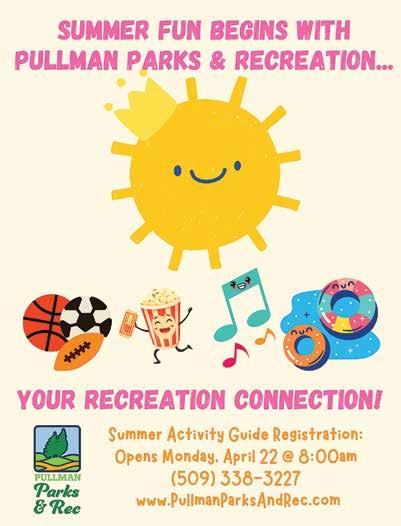

Learning lessons from past trials and “failures” (it’s not a failure if you learned from the experience) is helpful in building resilience. When I was nine years old, I found a love that changed my life: gymnastics. My mother later told me it saved her from going crazy—I had an outlet for my seemingly endless energy. At first, I participated in an after-school program taught by our P.E. teacher. My best friend had been a gymnast for a while, and I desperately wanted to catch up to her skill level. Some things take time, no matter how hard you work. I learned to bounce back from discouragement and work even harder. By the time I was in high school, I was serious about competition and had a dream to be a college gymnast. There were times I felt so discouraged. I went to every practice, showed up on time, listened, and worked my tail off. I performed routines over and over, aiming for perfection. I practiced and stretched on my off-time.
Another girl on the team simply had natural ability, I decided, because she missed practices, showed up late, and could learn a new move virtually the first time she tried it. Life was so unfair! In meets, we would alternate who won certain events, but she almost always beat me in the all-around score. It drove me crazy. One evening, I was feeling terribly sorry for myself. Apparently, my whining and complaining reached epic levels because my mother sternly told me to lock myself in the bathroom (guaranteed privacy for a bit in a house with three siblings) and to figure out my attitude. I did some screaming and crying, let my frustrations out, then realized it didn’t do me any good to be so upset. All I could do was what I knew was right—keep working hard and worrying about myself and not what someone else was or wasn’t doing. Learning the tough lesson that life isn’t always fair was an important step in building resilience.
Resilience is a popular buzz word in education today, and for good reason. Students need to be able to see a project, assignment, or piece of learning through to the end, not give up partway, declaring, “It’s too hard.” Parents can help teach academic resilience too, not just their teachers. Start them early by reading to them, then when they are old enough, find a book that can challenge them just enough to work that resilience muscle without snapping it. Teach them to persevere and read an entire chapter book. The same is true with writing. Start them off writing sentences, then paragraphs, then a short story. Journaling or writing poetry about your journey through difficult times can be beneficial, as is reading stories about resilient characters. These are documented methods for building academic resilience.
Taking ownership is another path to learning resilience. I created a curriculum that I teach my eighth-graders in Careers class. Jocko Willink, a former Navy SEAL, has co-authored a book titled Extreme Ownership. He has many lessons and principles in his book and podcasts that are geared toward persevering and bouncing back. When we take ownership of things in our lives, the good and the bad, we use discipline. That discipline takes over when we just aren’t feeling it. When we are disciplined with things in our lives, we build resilience. Emotions and motivation may betray us, but discipline can kick us into what he calls destroyer mode. Working hard, learning from mistakes, dusting off, reloading, and getting back out there are components of his message. Families are uniquely qualified to help each other along their journeys to resilience if they are aware, intentional, loving, and supportive.



What are some other ways to build this family value? In younger children, start with having them be responsible for cleaning their rooms. A rarity would be a child who loves to clean and organize. (I have heard some do exist out there, as mythical as Sasquatch.) The rest: well, from a young age, pulling every toy out, tossing them around, then leaving them were they lie is the norm. (Beware when you’re walking around in bare or stocking feet!) In a child’s eyes, it seems like you are asking him or her to do an impossible task. They can pick up two or three items, then have a meltdown. You can teach resilience with this mundane task. If your child feels overwhelmed, chunk it into sections: first, pick up the books and put them back on the shelf. Once they see they can meet that goal, ask them to pick up the stuffed animals, trucks, or Legos. Receiving praise for accomplishing small goals along the way teaches them to not only chunk goals into manageable bites, but that they can be successful with tasks that fist appear daunting. Be sure and celebrate when they are finished.
I’ve recently written about outdoor activities in my articles for this magazine and how beneficial they are to participate in as a family. Remember our hike up Colorado’s highest peak? We supported our daughters when they thought they couldn’t make it. Standing at 14,439 feet high up in the Rocky Mountains gave them a huge measure of confidence that translated to their everyday lives. My husband, Trent, started participating in 3D bow shoot competitions and graciously began to include the rest of us in his “guy time.” Hiking up and down hills, dealing with equipment issues, looking for lost arrows, and encouraging discouraged children definitely taught us resilience, but also our three girls. They stuck with it through ups and downs, physical and mental discomfort, and eventually they won some awards. They learned that if they didn’t give up, they learned valuable lessons and skills, they improved those skills, and they found enjoyment in the experience. If we had given up because it was too much of a pain, or too much work, or have been selfish with “me time,” our kids would have missed out on important practice in resilience.
Let me close with a couple more thoughts. Assigning children chores promotes resilience as it is a long-term commitment—feeding animals every day, whether you feel like it or not, mowing the lawn when you’d rather be swimming or playing.
Foster a growth mindset. Instead of allowing counterproductive thoughts to invade and discourage, lead your family in different ways to think positively, using “real-time resilience responses” like, That’s not true because…, A more helpful way to see this is…, or If x happens, I will y. Remind yourselves about your values and where you draw your highest dose of strength from: make that medicine your family.
Make every day have meaning and purpose. Loving your children in words and deeds is essential to them feeling like they’re important and have purpose in life. Create an environment where they feel accepted, free to communicate, and free to give something difficult a try. As parents, mobilize sources of faith and culture. Identifying with these elements brings meaning and purpose. Learning resilience brings hope, which seems to be in short supply these days.
Where do you learn those values? Your family. How do you learn those valuable lessons? With support from your family. I’m excited to think about the possibilities of what you will accomplish in your family.


Zen and the Art of Grill Maintenance
Tony Niccoli
Spring. The time of renewal and rebirth. As the rain falls here in the PNW the breeze that carries it is just a little warmer, and our hearts a little more receptive to the idea of embracing something new. We see the first buds break the surface, displacing soil in their stretch for the low-angled sun, and witness birds reversing their southerly route to once again grace us with morning song. Our promises of growth and change in the new year have either reached the point of habit and substantial change, or faded away into distant memory. Never in the course of the year is there a better time for cleaning and talking stock of what we see before us. Deciding what brings joy and giving it extra attention, determining feels too difficult to maintain, and finally letting it go.
A few years back, about this time, I did a really deep focus on time and where I placed my energy. I wrote a little about it here in the magazine and continued to practice what I had learned along the way. One of the standouts for me was expanding my understanding of spring cleaning to include items like archived emails and digital folders. Dropping those skipped tracks out of playlists, and fine tuning everything in your daily life to best suit your ever evolving needs. For some clothes, bookmarked webpages, and junk drawer relics this means the end. My mind is freed up and I no longer carry the burden of owning that which doesn’t bring me the greatest joy. For other objects, I find a strengthened sense of connection, and devote a little time to caring for them, prepairing mentally and physical for increased interactions in the year to come.
My grills especially love this time of year! Obviously on the keep and care-for list, I can almost hear them sing with joy as the cleaners come out, fresh rags are prepared, and an afternoon is lovingly devoted to showing them tender care and appreciation. Meanwhile, waiting in the fridge is something special. I like to finish the day of cleaning by grilling something a little more delicate or finicky. Something that would be nearly impossible without putting in the time to get a perfect grilling surface. Delicate items will always stick to a dirty grill. You go for a the flip and find little chunks tearing away and left behind. What’s worse, along with destroying the exterior texture, you are going to impart acrid flavor! Yuck. So besides being a virtue unto itself, knowing that you have a spotless grill waiting outside imparts an extra mental freedom. You realize that at any moment, you can come home with any food imaginable and that trusty grill is ready.
If its been a long while since you last cleaned, start by removing the grates, and any heat shields and get them soaking in a tub with hot water and dish soap. I used to use a lot of premixed grill cleaners and heavy chemicals, but have recently soured on the idea of bringing that anywhere near food. Now dish soap is the toughest, and I do a lot of the scrubbing work with vinegar. A little extra soak while you scrub out the kettle or base will be all you need to get them looking like new again. Remember to be in the moment and connect with the art of cleaning if you really love to grill. It sound funny but this truly is bonding time that will pay off in your increased appreciation for the feast you cook later. So tidy your mind, tidy your grill, and then treat yourself to something that might have been much more difficult to pull off on a dirty grill. How about skin-on fish and some delicate marinated veggies? Now that’s a bite of spring!




Home Equity Line of Credit*
To mix up your marinade, start with the most important ingredient and go from there. In this case lemon juice or some vinegar it usually my go-to. For this recipe, I’m going to use some lemon juice and a little dijon mustard for my base, and then add some butter and fresh herbs to amplify the taste. Its going to work perfectly as a marinade for the veggies and will also make an excellent drizzle for the fish once everything comes off the grill. With this unique pairing, you can really amplify the flavor of the meal and you’ll find yourself reaching for a lot more veggies that you normally would! I’m mixing the juice of two lemons with three tablespoons of Dijon mustard, and the zest of one of those lemons. Put this into a sauce pan and add one stick of butter, gradually bringing up the heat to let it combine. As you are heating, stir in ½ cup of chopped shallots, 1/3 cup of olive oil, 2 tablespoons of fresh thyme, and a heavy dash of salt and ground black pepper. Allow it to cool just enough to go into the baggie, or brush it directly onto the veggies and let them sit while you prep your grill and fish.
For the fish, I’m going to recommend sea bass, rockfish, or red snapper. With a thicker cut you will be able to get a little more flavor by going directly over those sparkly clean grates and still manage to get a perfect sear without overcooking. Something thinner and flakey might require a basket or foil so we want to make sure that our fillet can stand up to full contact grilling. To prep my fish, I like to use a simple process of rubbing both sides with some olive oil and then using salt and pepper on the fleshy side. For something over higher heat I would avoid the olive oil because it has a lower smoke point, but here we are going to be cooking indirect over a medium flame so that won’t cause any trouble and I enjoy the flavor better than most of the alternatives. When you are ready to grill, give the grates a quick pass with a mop or brush dipped in oil, and wait a moment to make sure they don’t smoke or flare-up. Then put the fillets on skin side down and close the lid. We are trying to keep the overall heat up and cook the inside as well as getting that delicious caramelization on the bottom. And since they won’t be flipped, working that heat from all sides and the top is key to getting a good cook. If you are cooking at a park or campsite over an open flame without the aid of a lid, then expect to run longer before reaching safe temp, and know that you might overcook the skin. I don’t mind a little extra crispy but once you get to fully burned its best to just remove it gently as you are serving. Either way, leave it on there during the cook to act as a barrier and to protect the rest of the fillet.
If I’m grilling fish with a flip, I expect about 6-7 minutes per side at the longest. Without the flip it can easily go past double that, so expect around 15-18 minutes. Safe cook temp will be 145 degrees, and as always, a probe is the best way to be accurate. But fork-flaking, with opaque coloring and firm texture is the closest approximation if you cant get the exact temp. Remember that you do get just a little carry over once it leave the heat, and plan to have it sit for a few minutes before serving. I like to wait until the end of the rest period to drizzle on some of that extra marinade so it won’t just run off.
Give the grill a quick scrape while its still hot and renew the vow to keep it looking spectacular this year. Great food comes off of grills that are treated with love and care.
May your minds be ever clear, your grills always clean, and the cooler perpetually stocked. Happy spring grilling!



ITALIAN easter bread
Kitchen
EMORY ANN KURYSH
INGREDIENTS
Makes 2 loaves
1 cup milk
1/4 cup butter or margarine
2 teaspoons quick rise yeast
1/8 teaspoon salt
1/2 cup granulated sugar
4 large eggs
3 cups all-purpose flour
2 cups water
2 teaspoons vinegar
Food coloring
STEPS
Sprinkles In a small saucepan or microwave, add the milk and butter. Heat until melted. In a bowl, combine yeast, salt, sugar, and 1 beaten egg. Pour in the warmed milk mixture and stir. Then add a cup of flour at a time, possibly needing more to ensure it’s not too sticky. Transfer dough to a floured surface. Knead for 5 minutes, forming into a ball. Transfer back into a greased bowl, covering with a tea towel or Saran Wrap, and putting it in a warm location. Let rise for 15 minutes. Remove dough from bowl. Separate ball into 6 equal pieces. Take 3 of those pieces and turn them into 1” ropes approximately 12 inches in length. Pinch the ends together, making a braid. Then take the bottom of the braid and bring it to the top, looping it into a circle. Repeat once more. Take both braided circles and place them on a cookie sheet with parchment paper. Cover with a tea towel and let rise for 1 hour in a warm location. Meanwhile, combine the water, vinegar, 40 drops of food colouring, and 2 eggs into a small saucepan. Boil for 15 minutes or until they become hardboiled. Remove from water and set aside. Preheat oven to 350F. Once bread has risen, brush with egg wash and 1 teaspoon of water. Top with sprinkles. Place one egg in the center of each. Place in oven and bake for 18 minutes, or until golden brown. Remove, top with butter, & enjoy.
Home&Harvest | March+April 2024 25
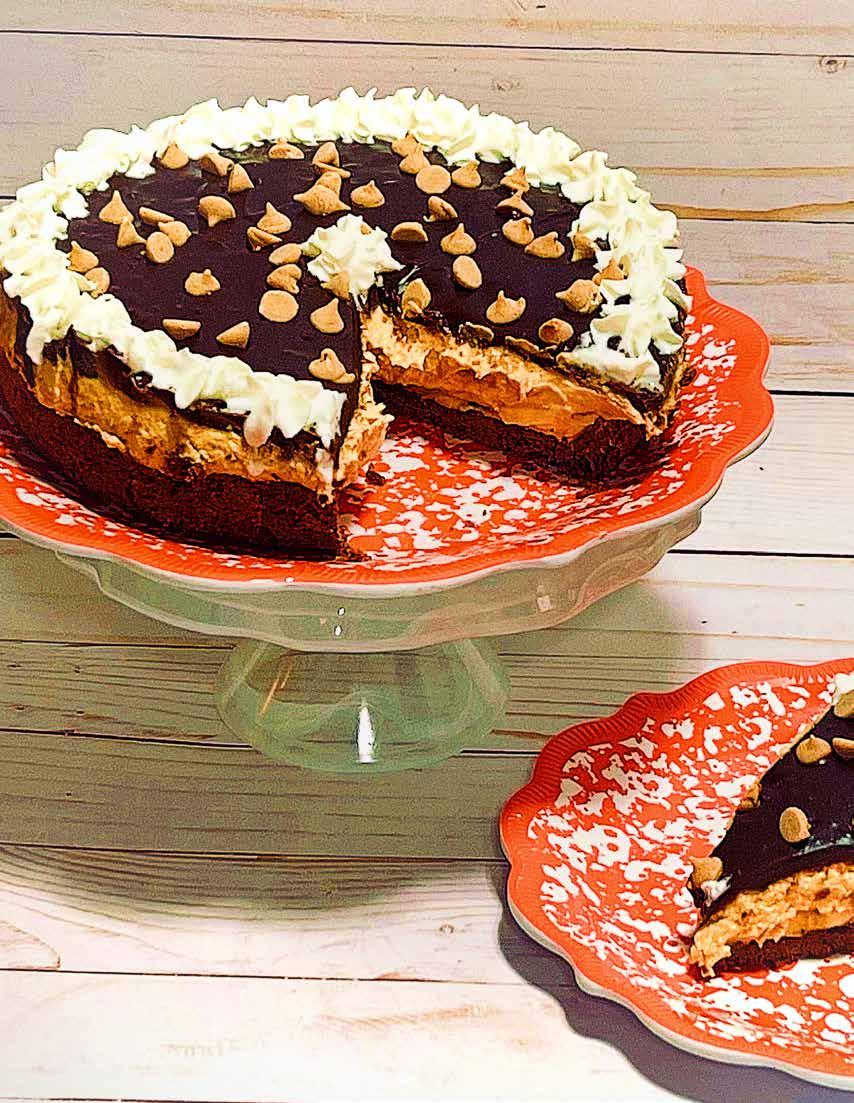
PEANUT

PEANUT BUTTER
banana pie + chocolate cookie crust
KITCHEN
INGREDIENTS
1 1/4 cup all-purpose flour
1/3 cup granulated sugar
sara raquet
1/4 cup Dutch-process cocoa powder
1/2 teaspoon kosher salt
10 tablespoons melted salted butter
1 (14-oz.) can sweetened condensed milk
1 (8-oz.) block cream cheese- room temperature
1 cup creamy peanut butter
3 large bananas, thinly sliced
Ganache
1/2 cup heavy cream
6 ounces semi-sweet chocolate – chopped
STEPS
Preheat oven to 375°. Lightly grease a 9” pie plate or springform pan with cooking spray. In a medium bowl, whisk flour, granulated sugar, cocoa powder, and salt. Add butter and mix with a wooden spoon until the dough comes together. Press dough into bottom and up sides of pie plate. Using a fork, crimp edges, if desired. Poke holes all over bottom of dough. Place pan on a large baking sheet. Bake crust until no longer shiny, 18 to 20 minutes. Let cool. Using an electric mixer on medium-high speed, in a large bowl, beat milk, cream cheese, and peanut butter until smooth. Arrange banana slices over cooled crust, slightly overlapping. Pour peanut butter filling over bananas; smooth top. Cover with plastic wrap and refrigerate until well chilled, at least 2 hours. Now, create the ganache topping: add the chocolate to a medium sized bowl and set aside. Add the heavy whipping cream to a microwave safe bowl or measuring cup and heat for about 1 minute, keeping an eye on it. Pour the warm cream over the chocolate chips and allow to sit for 3-5 minutes. Gently stir the cream and chocolate together until they come together to a smooth consistency. Pour over pie and return to the refrigerator. Yum!


CHOCOLATE Cake & Ermine Frosting
INGREDIENTS | cake + frosting
1 3/4 cups all-purpose flour
3/4 cup Dutch process cocoa powder
1 1/2 teaspoon baking powder
1 1/2 teaspoon baking soda
1 teaspoon salt
2 cups white granulated sugar
2 large eggs- room temperature
1 cup milk room temperature
1/2 cup melted coconut oil
2 teaspoons pure vanilla extract
1 cup strong hot coffee
Ermine Frosting
1/2 cup all-purpose flour
2 cups granulated sugar
pinch salt
2 cups milk
2 teaspoon vanilla extract
2 cups unsalted butter room temperature
STEPS
Preheat oven to 350°F
Lightly grease 2x 9-inch round cake pans with butter. Line base with parchment paper. Sift together flour, cocoa, baking powder, baking soda and salt into a large bowl. Whisk in sugar, then add eggs, milk, oil and vanilla. Whisk well to combine until lump free, about 30 seconds. Pour hot coffee into batter, mixing well. Cake batter is thin in consistency. Pour batter into cake pans and bake for 30-35 minutes or until a wooden skewer inserted into the center comes out clean. Let cool for 10 minutes, then turn out onto wire racks to cool completely before frosting.
Frosting Instructions:
Place sugar, flour, and salt into a medium saucepan. Whisk to combine. Add milk and vanilla, stir to combine. Cook over medium heat, stirring constantly, until the mixture boils. Continue cooking while stirring constantly for 1-2 more minutes until the mixture thickens to a pudding-like consistency. Remove from heat. Pour into a bowl and place plastic wrap directly on top of to prevent skin from forming. Cool to room temperature. *Using a stand mixer or hand mixer, beat the (room temperature) butter on high until pale and fluffy (3 mins). Continue beating the butter and add the cooled milk paste 1 tablespoon at a time, waiting until the first addition is fully incorporated before adding more. Stop periodically to scrape down the bowl with a silicone spatula. All in all, it will take about 5 minutes to incorporate the milk paste into the butter. When all the milk paste is beaten in beat on high speed for 2 minutes to fluff up the frosting.
RAQUET
Kitchen SARA
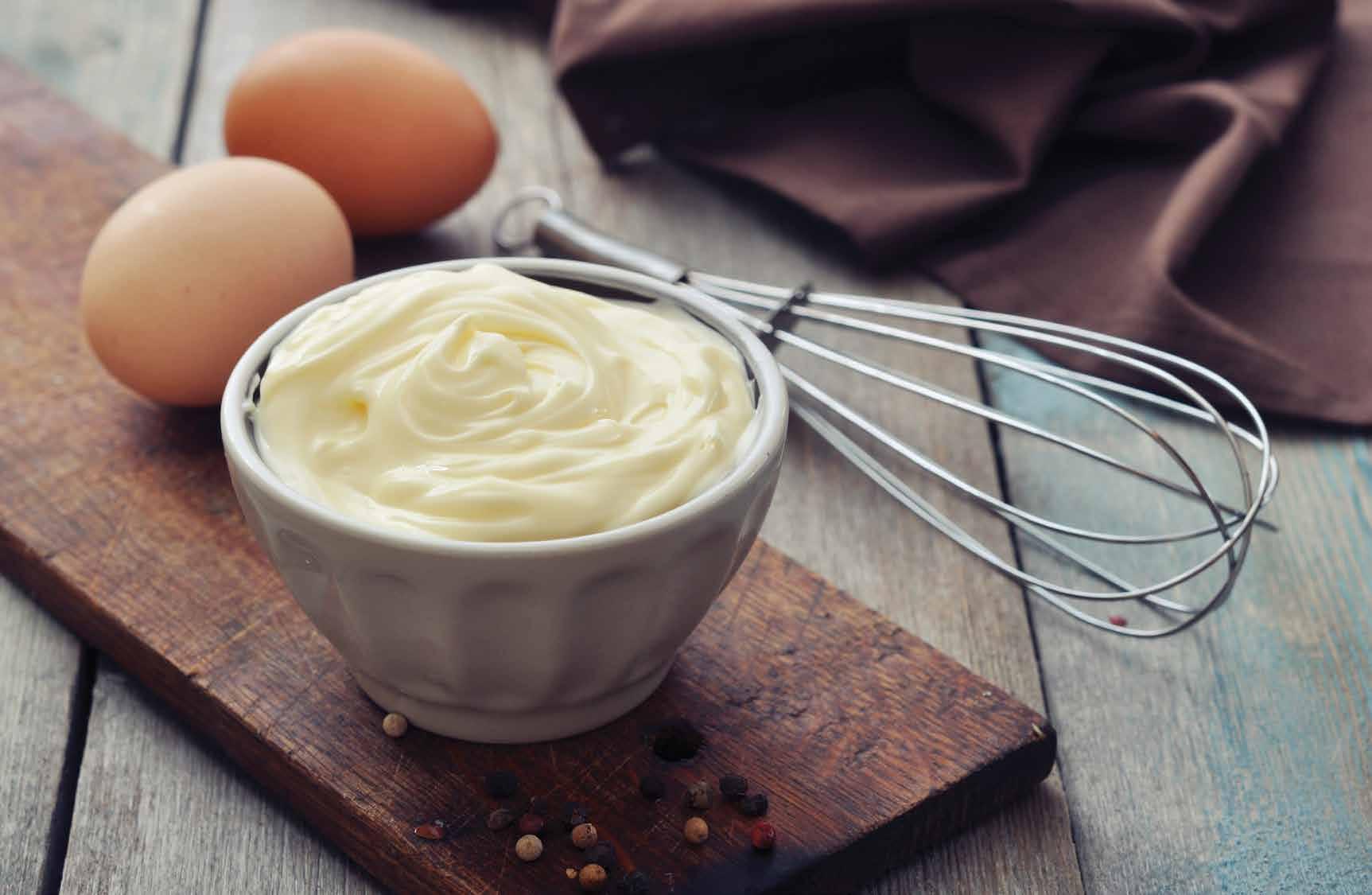

HoMeMaDe
Mayonaise
KITCHEN
A few years ago, I began making my own salad dressing. It started with ranch and has branched out to vinaigrettes. I love thinking about this old-fashioned way of cooking and how much of a taste and cost difference it makes. Someone recently shared with me that mayo, of all things, is incredibly simple to make. I was worried about the raw egg but it’s the same technique used in store-bought mayo. Last week I finally decided to try this and the result? INCREDIBLE. You will not go back to storebought mayo! I’ve learned that the hydrogenated oils in many of our sauces cause inflammation in our body. With mayo being at almost $7 a jar, this is a complete win all around. The result is extremely creamy, tasty, and is actually fun to make! You can use any oil, but for the best taste I recommend avocado oil. My first attempt was with olive oil and it had too much of an oil taste- but it was still delicious. Trust your taste buds and your instincts. You know you and your family best. Have fun- try different variations with spices and enjoy!
INGREDIENTS
1 cup oil
1 egg, room temperature
1 tablespoon lemon juice
1 teaspoon Dijon mustard dash paprika
1 teaspoon salt
¼ teaspoon ground black pepper
STEPS
Using an immersion blender, regular blender, or mixer, combine the oil, egg, lemon juice, Dijon mustard, salt, and pepper in a large bowl. Begin to blend until the mayo is totally emulsified- it’s like magic before your eyes! Transfer to your favorite food storage and label the date. Most homemade mayo has a shelf life of around two weeks! Trust me, it will be gone long before then!
Heather Niccoli
buffalo chicken crockpot dip
Kitchen
heather niccoli
Whether you’re eating a keto diet or just wanting a simple, delicious meal to forget about in the crockpot, this is it! It also makes for a great cold lunch to go with celery sticks!
INGREDIENTS
4 chicken breasts, uncooked
1 pkg cream cheese
6-12 oz Franks Buffalo Wing Sauce
2 tablespoons butter
garlic and onion powder to taste salt and pepper to taste
1 baguette toasted, if desired blue cheese crumbles + parsley, if desired
STEPS
Place the chicken breast in the crockpot, and turn it on to high. Season with the salt, pepper, garlic and onion powder. When it doubt, use extra! Pour the entire bottle of wing sauce if you like a lot of flavor, or half if you want a milder taste. Place the cream cheese on top and cover. Let it simmer for about 6 hours on high, until chicken is cooked thoroughly. Use two forks to shred the chicken and then stir the cream cheese, chicken and wing sauce together, till combined. Serve with blue cheese crumbles and toasted baguette slices, or celery for a healthier version. Super simple and delicious!


hummingbird cake
& Cinnamon Cream Cheese Frosting KITCHEN
INGREDIENTS | cake + frosting
½ cup unsalted butter room temperature
¾ cup sugar
¼ cup brown sugar packed
2 eggs room temperature
2 ½ cups flour
1 teaspoon baking soda
1 teaspoon salt
2 teaspoons cinnamon
1 ½ cups bananas mashed
1 teaspoon vanilla extract
8 oz crushed pineapple with juice
1 cup shredded coconut
½ cup pecans chopped
Frosting
½ cup unsalted butter room temperature
8 oz cream cheese room temperature
1 cup powdered sugar
2 teaspoons vanilla extract
1 teaspoon cinnamon
¾ cup pecans chopped, for garnish
STEPS
Preheat oven to 350 degrees and coat two loaf pans with non-stick cooking spray. Whisk together flour, baking soda, cinnamon, and salt in a large mixing bowl. In a separate large bowl, use an electric mixer to cream the butter and both sugars. Mix in the eggs and vanilla extract. Gradually add the dry ingredients to the bowl of wet ingredients, mixing until well combined. Stir in pineapple, coconut, pecans, and mashed banana. Scoop batter into prepared pans and bake for 35-45 minutes, or until a toothpick inserted in the middle of each loaf comes out clean.
Cinnamon Cream Cheese Frosting:
Beat together all frosting ingredients (except pecans) until smooth and fluffy. When bread has completely cooled, spread frosting generously to coat. Sprinkle with chopped pecans.
 Sara raquet
Sara raquet
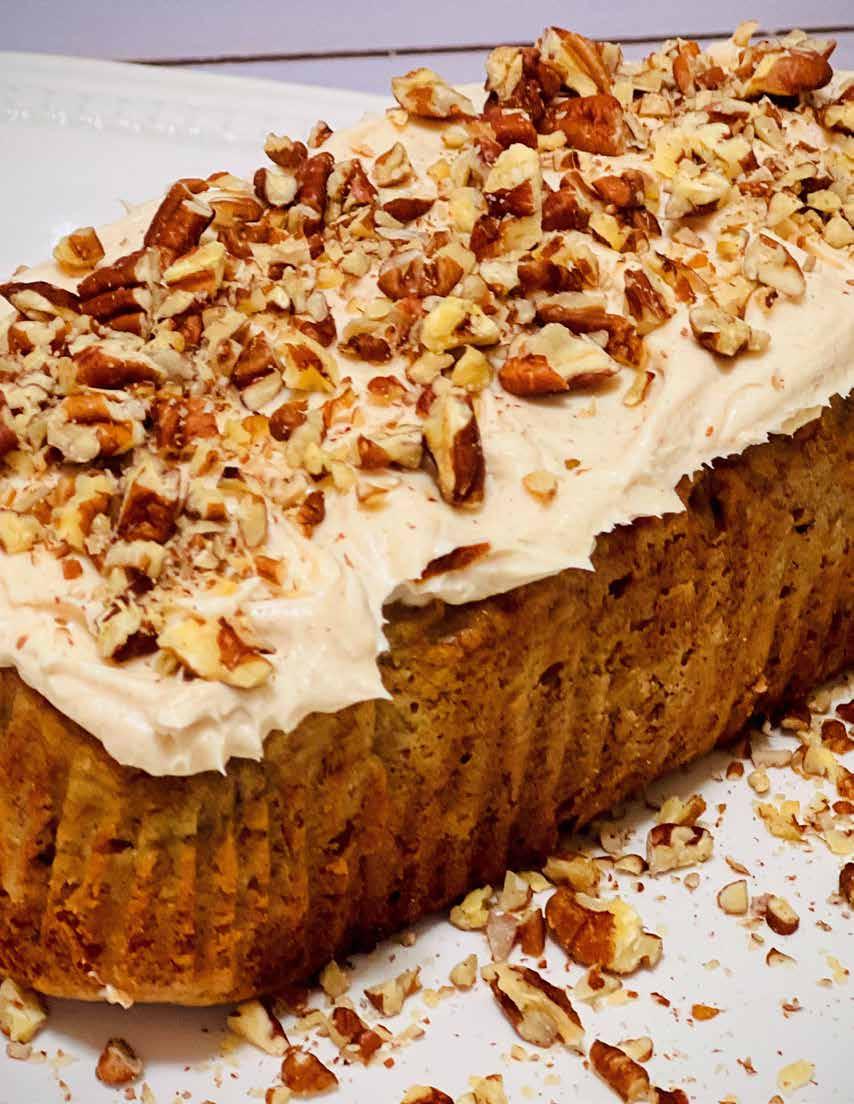

Spring ! My favorite time of year. Nature is waking from her nap, the glorious signs of renewal are all around us and the earth calls to be planted to provide us sustenance. It also ushers in my birthday, and it’s a big one this year. Mark Twain said, “Age is an issue of mind over matter. If you don’t mind, it doesn’t matter.” Fully alive with energy and staying power, I am grateful for my continued abilities and accept the increasing gravitational pull on my anatomy. I can still do it all, just slower. I tend to limit my weekly undertakings to a more manageable schedule. Lunch next Thursday? No, I have to take out the garbage. The shoe horn has become a useful companion and the mirror is not. A cool telescoping walking stick has found its way into my car but not my hand. Vowing to grow older with humor and acceptance, I choose to call them signs of being physically mature. I am guessing I am not intellectually mature since I still cannot figure out that Wall Street Journal crossword puzzle or understand some of the headlines. I have accumulated bits of knowledge and realistic perspectives from academia, independent reading of diverse topics and celebrated authors, several different careers, several different therapists, and raising a basically wholesome family. I have even checked each of the boxes; single-married-separated-divorced. This substantial bundle of achievements has gained me the status of being ‘older’ but as I reach the false summit I see there is another step up to ‘older and wiser’. Looking on from my septuagenarian vantage point, I think I discern an opening door. No, not the pearly gates but there is a sense of omnipotence and epiphany. A simple and powerful insight surfaces from the recesses of my unconscious to full consciousness; ‘Permission granted to be liberated from the toilsome search for approval of others and become an unrestricted version of yourself.’ My intuitiveness is becoming louder, crowding out inhibitions. Confidence is finally silencing nagging self-doubts. A peaceful, true calm finds its way into my breathing meditations. Where was this message when my spirit was young and desperately trying to come forward? In the face of intimidation, societal norms and uncertainty can bully us to cower and shrink, making it difficult to find our truths. Better late than never to employ my concealed strengths and take a seat at the table. My name is in capital letters on this place setting now.
“Aging is an extraordinary process where you become the person you always should have been.” (David Bowie)
If I could imagine life as a metaphorical feast from the perspective of me as a tiny young girl seated at a table with the assemblage of all the loving friends and family that would grace my life’s path, it would look like this; With the wide open eyes of a child, seeing no restrictions on my self-worth, I’d boldly order a side of everything on the menu. The appetizers, offering remarkable tastes of astonishing things, would stimulate an endless appetite for knowledge. The steaming, hearty soups of slow simmered interpersonal connections fill my bowl and soul with ladles of love while sensational salads offer combinations of wonderful experiences tossed together and seasoned with travel, music, culture and the arts in a perfectly complementary blend. The sweet and comforting aroma of warm, freshly baked bread envelops the table like a memaw’s hug and steaming slices of glorious conversations are enjoyed throughout the feast, served with wedges of fine cheeses that have improved with age just as I will. My vegetable selections would be endless varieties, -



-freshly harvested from the bountiful garden of maturity. Of these I would mound second and third helpings, aspiring to develop into a well-balanced adult. For the main course, I would select something that offered a fascinating and satisfying life purpose smothered in a savory sauce of passion and dedication. And at last, the decadent array of desserts. I would fill my plate with every confection available and set my sails through retirement on a sugar high, the frosting on a well rounded life. A pleasant conversation should always follow a fine meal so after said imaginary feast, I would politely engage the guests in attendance to help clarify my moderate confusion about age and maturity. Age is a solid and defining number but what is maturity if it does not automatically increase with age. There are grown-ups who still act like kids, there are kids who are more mature than some grown-ups and then there are all of the rest of us in between. The best I can tell, it has something to do with being able to observe and handle behaviors of others around you. Other basics include the ability to control your emotions, to make good choices for yourself, to not bend to peer pressure, to treat others with the same kindness that you would like, and maybe being able to see how to do as much good as one can. There was a time I thought red lipstick and the ability to walk in high heels were signs of maturity. I was sure I would automatically be mature when I started dating. Then I expected it to arrive with the means to move away from home and support myself. Nope. None of the above. In fact all of those things pretty much proved to me how immature I really felt. What does maturity feel like? Even as an adult, in spite of my determination to be my best self, I have thrown tantrums, shirked from being accountable or taking responsibility on more than one occasion and behaved in ways that can only be described as a child seeking attention. This is the human experience we are all navigating with no steering wheel until we get a grip on self-awareness. Until then, who’s driving the dang bus? Our emotions. Reviewing a gaggle of my own unique life experiences, I became aware that some of them occurred a very long time before I figured out what to learn from them. Throughout the course of our lives, we continue to develop threads of self knowledge, hints of emotional growth and maybe a tingle of that elusive mistress, maturity. Maybe maturity does not arrive until you realize just how many years you have waited to know it all and then learn you are still wrong. Like when you say; I don’t have to write that down. I’ll remember.
“With age comes wisdom, but sometimes age comes alone.” (Oscar Wilde)
So what does maturity look like? Am I my mature self now because I look old? I don’t think it is that easy. I can dress frumpish or attempt to appear stylish but neither will reflect the growth of my soul. I want to be known as who I am more than how I look. I don’t think maturity is a stage that has outward clues as we look at ourselves. It is more of an inner presence. You have watched that poised person walk past you on the street or in a restaurant, who seemed to emanate calm. You noticed more than their posture or coolheadedness. They projected a balance of confidence and conviction without approaching self importance, conceit or vanity. Their presence had a kind of quietness, a sense of reserve and true humbleness. No matter how straight I stand I do not feel like that. I even tell myself to put my shoulders back, stand tall and think positive thoughts but I still feel short of the mark. I have had people tell me that they see me as a calm and-
-confident person. It is hard to accept that I have that vibe but on occasion I might. Especially when I smile from my heart. Maybe when we focus on our own truths it allows them to shine through and become that outward clue. It takes some time to manifest but incredibly stunning when authentic. Put one on and see if you agree. I think that kind of smile might be one of the essential basics of a truly mature person. We may not like the image we see in the mirror on the wall but if we can gaze into the mirror of our soul we see beyond vanity.
I am not an authority on the process of aging. Only of my own. I am an authority on the beauty of my transformations. Some of them are as large as mountains and some as small as a grouping of words. Like when you say; “Things like this always happen to me.” Instead of the words ‘to me’ say ‘for me’ and see how it changes everything. That is a transformation. A chrysalis to a butterfly. Another favorite is by Confucious; “To know that we know what we know, and that we do not know what we do not know, that is true knowledge.” This helps me to avoid arrogance and coaxes me to find my truths. I am confident when I say there are things that I know today. I know my adult children love me. I also know that they are still not interested in my opinions or practical knowledge that I might be tempted to offer them today or ten years from now. I have finally learned to keep my expectations reasonable. I have learned resilience. I have learned to look for and find humor, love and beauty in any direction. I know how to create happiness because I have learned it is a choice and that I am empowered by love, the connection with ourselves and others. I know that awakenings can happen at any time, like trees budding in an eternal spring.
As for the things I don’t know, the speed of technology has made that list grow by the day. In addition to not understanding my computer, bluetooth keyboard, smart tv or cell phone, I don’t even know how to book an airline flight because so much has changed since I last traveled. I even failed an attempt to enter the campus parking garage last week to attend an event at the art museum and couldn’t create an account. How will I ever rent a car or get an uber? I feel as though the answer to “What is the meaning of life?” must be “Download the app.” This added step to everything looms as a giant obstacle to seeking any and all activities awaiting me and has brought me to tears more than once. I don’t know why technology has arrived and taken over but I will have to find tutorials for all of the above, because the alternative is to sit here and play another hand of solitaire.
“You can’t do anything about the length of your life but you can do something about its width and depth.” (Evan Esar)
Ugh. No, I cannot suffer another shuffle. I have a talk with myself…. I do not want to sit home alone tonight. I need to dismiss my fear of operating solo and expand my comfort zone. So I did. Last Friday night I gave myself permission to stay out after dark and go do something fun. I love live music. I made a table reservation online (no app) at a Spokane winery hosting a good blues guitarist, recited verbal encouragement the whole drive there, rented a nice room overlooking the river, dressed in lady clothes and continued reminding myself how much I would enjoy the event. I boldly walked to my reserved but random seat at a table of total strangers who watched me approach from the crowded room and walk across the vacant dance floor.


Round up your debit card purchases & save like never before!







Loot Saver HOME LOANS | PERSONAL LOANS | BUSINESS LOANS | CREDIT CARDS
LATAHCU.COOP Moscow|Kendrick|Plummer|Potlatch
The voice in my head wanted to question my decision but I knew I wanted to be there. After drifting into my seat right next to the stage, my gaze revealed an entire room of friendly and welcoming people my own age. My mind reeled. I was not a deviation but the norm. This was unfamiliar and bizarre after decades of bobbing in a vast sea of twenty-somethings. I gained a new and priceless perspective. I am not alone, I am only isolated while residing in a college town and need to broaden my boundaries by expanding my horizons. I enjoyed every classic blues song, some fine wine, some moves on the dance floor and swapping similar stories over the cacophony of the jovial crowd and faultless guitar riffs. Unexpectedly, I made four new friends offering invitations for numerous future music events so I won’t find myself unaccompanied, unless I wish.
A table for one should never be a crippling affliction but the fear of being alone can be paralyzing. I can’t let it stifle me and I must remember that headlines will often if not always sensationalize negativity, manipulating the truth to get clicks and sell newspapers. There is no denying the atrocities we are seeing today but I refuse to believe that our world has become too dangerous to enjoy our surroundings. Evil does not lurk in every dark corner. Venture out in safe settings and exercise caution where needed but be sure your fear is not just about going someplace alone. There are a lot of folks young and old alike finding traveling alone to be amazing. Social media is full of solo travel blogs professing the benefits. If you are the only one creating the itinerary, you are the one to decide your destinations, how long you stay, what and where to eat. You also have unlimited chances to strike up conversations with interesting folks you would not meet in the company of a traveling partner.
It’s time for the frosting and my retirement is fleeting. I am untethered, a canoe with its bow pointing out to open water. What an incredible place to be. No more hesitancy. Where do I want to go? What do I want to do? I just have to stretch my memory to recollect the definition of fun. Fun; enjoyment, amusement, lighthearted pleasure. Oh ya, that used to mean climbing trees, playing soccer, running on a sandy beach, rowing across a lake, holding a salamander, waking up in a tent at dawn on a warm summer morning to only the song of birds.
I put those aside for acting my age, a somewhat long and arduous undertaking. I thought deprivation was a synonym for grown-up but it is not. It turns out I often denied myself joy and almost reached emotional impoverishment. We should never leave out things that bring us happiness. I think saying ‘I got too busy’ is just an excuse almost as bad as saying you couldn’t find someone to go with. There is merit to being your own best friend. One of those transformations I mentioned earlier that was as large as a mountain was recognizing that the longing for someone to really know me, to understand who I really am, wasn’t loneliness but a solicitation to love myself. Never be too busy for yourself. It leads to shaping your own world instead of letting someone else.
So what is my truth today? I agree wholeheartedly with Madeleine L’Engle’s words, “The great thing about getting older is that you don’t lose all the other ages you’ve been.” I am still that little independent tomboy. If I want to climb trees as a grown-up I can ride a zip-line through the forest canopy or get a vacation rental in a treehouse. There are unique rentals like wall-tents, yurts, train cars, and tugboats. Several years ago, before I had any nagging thoughts that I was getting old, I stayed in a large cabin cruiser that was a vacation rental but remained at a marina. It was an affordable way to visit my son with plenty of room for hosting a group of friends up on the spacious deck. I’ll do that again and maybe even take a canoe for a quiet paddle around the cove. When I dismiss the judgment of other people I can still kick the soccer ball around, fly a kite, ride my old schwinn with the wicked-witch-of-the-west basket, hit tennis balls against a wall, or dine in public and not feel an odd spectacle without a companion. The lesson was taken to heart that night I went stag to enjoy live music. My tribe is out there and I will run into them when I am being myself. Perhaps it will happen again when wandering alone at a museum or following the sun south to marvel at spring cacti blooms in the desert lands. Still very fond of camping and everything that goes with it, I have not set out as often as I thought I would. What could be better than reading outdoors, not making my bed or worrying about dirty feet? The incense of woodsmoke and the hypnotic companion of a campfire can be enjoyable solo or with some entertaining storytellers or guitar strums. Yes, I know I will have to reserve a campsite online. I can’t let the ambush of apps stop me. I can do this. The feast of life beckons, and I must binge on its desserts.
“Aging is not ‘lost youth’ but a new stage of opportunity and strength.” (Betty Friedan)
I am not alone looking at my wrinkles and being reminded of my youth. There are multitudes of respected icons of the 60’s speaking out to encourage us to recognize agelessness and reawaken our potential. Senior years reflect collected wisdom, valid and timeless. The list of best selling books by older authors reflects our hunger for guidance. The average age appears to be fifty but a large percentage of best sellers are by authors between sixty and seventy.
“Getting old is like climbing a mountain, you get a little out of breath, but the view is much better.” (Ingrid Bergman)
Home&Harvest | March+April 2024 41


Spring with a farm -part 1-
The work and worry of having a farm in the spring is a dose of reality for those of us who love the blossoms, green grass and the brand new leaves.
Form the very early days of closely watching the sky, to then listening to the radio every morning, to checking the app; farming has most certainly changed. The trick is to keep up with it all. Originally, as the saying goes, it was “40 acres and a mule”, but today it’s 1000 acres or more. Big business has gotten into farming, but there always was a richer farmer with a lot of acreage and a bit of a monopoly. You just hoped they were nice. Today, many a small farmer tries to make it by adding more acreage. The first plot now becomes a much bigger place to keep track of.
In our garden patches, we need to worry about good seed, depth of the seed, good weather, controlling the bugs and weeds, the correct amount of water and sun. Multiply our 5ft, 10 ft or even 40 ft. gardens with 1000 acres of plants. And in this Palouse area, depending just on the rain for watering. So watching the sky is still a needed task. Too much rain is also a problem which has been muttered by many a farmer in the spring; “Too wet to plow”.
This article will (as usual) jump around in time. The reason this is so possible is the common thread in all these lives in Genesee and at the Ranch.
From a 1921 Genesee News, also possibly heard on the new Radio, hooked up to a battery... “1921. GARDEN SUPPLEMENTS KITCHEN Aside from being a valuable asset in supplementing food supply and enlarging the family larder, a good garden may be made a pride of the farm.”
Home vegetable gardens will be just as important in stabilizing the food supply in 1921 as they have been at any time during the past few years, says the U. S, D. A.. Urgent need for increased production of food during the war caused thousands of rural and urban residents to plan gardens. This year home gardens will play an important part in thrift and economy.
One-tenth of an acre of fairly good ground-a square about 65 feet each way-will supply the greater part of the vegetables needed by the average family. The cost of all seeds and fertilizers for a garden of this size should not exceed $15 to $18, and may not cost more than $5 or $10. Experience has shown that not more than 100 hours should be required for planting and caring for a one-tenth acre garden. It means an average of about 5 or 6 horses a week for a period of 20 weeks. More time will be required early in the season while the garden is being prepared and planted than during the summer, when little more than 2 or 3 hours a week will be necessary to keep the garden in good condition.
by
Diane Conroy
A garden is like a farm, however, in that is produces according to the attention given it. A well-cared for garden will produce much higher yields than one which is neglected. The average return in money value from a one-tenth acre plot of ground usually is about $85 for a season. Plenty of fresh vegetables direct from the garden to the table is of vastly greater importance than the money value, the cutting out of middleman’s profits or transportation problems. The question of saving and cost, however, may prove a very important factor before the close of another year. Already there is much unemployment of labor and the local or home production of foods in the garden is the surest way of safeguarding the family food supply…1921
There is no more healthful exercise than that of working in the soil. The old doctor who advised us to go out on the farm and follow the plowman had the right idea. So simple an operation as hoeing or raking the soil brings into play muscles of the body that seldom do any work. Gardens and health go hand in hand. Even on farms where men do the heavy labor of preparing the garden, women find light work in the garden of greater benefit for the duties of the farm women often keep her too closely confined in the house and the garden affords an opportunity to get out into the open air and sunshine. More than half of the work of growing farm gardens is done by the women, any of whom would have no outdoor recreation if it were not for this work in the garden.”…1921
The buying of good seed, the proper depth of planting. Also, “What are the new hybrids?” is a big concern, when you are selling.
“1940, Genesee News. It is recommended that 50 to 60 pounds of Safflower seed be planted per acre. When planting, use an ordinary grain drill and set your machine to drop the desired amount per acre, but keep in mind the plants should stand from 4 to 5 inches apart in rows and the seed should be planted 1 ½ to 2 inches deep unless there is a blowing of the soil, where 2 ½ inches is recommended. Plants should appear above the surface of the ground in 4 to 6 days, depending upon moisture and temperature.”
“Idaho Pocatello News, 1930’s. according to Mr. Bennett, by planting better seeds and following more correct practice. “If I had the money that has been lost this year by planting poor seed, at the wrong time and at the wrong depth and following wrong cultural where Wisconsin seed sells for 90 cents, Idaho seed sells for $2.50. Lem-hi county growers get a premium of 20 cents in addition to this. The freight rate, of course, forces us to grow good seed, as we cannot afford to ship culls.”
Selling product. To whom, where and how much? And passing the quality evaluation. From a 1901 Genesee News.
“1901, Feb. 15. Jonathon apples have been selling for $1 per dozen in Chicago- those from Idaho. Price per box placed at $7. Our people planting apple trees with the expectation of selling the fruit to eastern buyers should bear this in mind. There were scarcely a carload of this variety raised in the Genesee Valley. Tons of poor apples are grown, but few of the choicest varieties.”
John Lorang sold apples by the carload on the train and did well with these. In the earlier days it was more difficult, everything-
-had to be hauled down the hill, to Lewiston, and sent out by boat.
In 1937, Mary Lorang writes a letter to her son Henry who is now managing the farm. Mary writes as English is her second language.
“April 26, 1937. “Dear Son Henry and Margurite and all. Well you said you had to steal the time to write to me I am sorry that you are so busy but although I should no that you are very busy anyhow this time of the year when their is so much to do and all the children going to school……Now my Son, if you could sell those peas for me I would not no how to sell them. maybe you could sell them for seed. Charles would not no where to sell them and he is so very busy with Thomas esteade. I hate to bother you with does peace but I think I better sell them before planting time. Are we going to get some allotement money this year yet are is it outlawed? I surely would need it, for I have halve the taxes to pay in June but I have a little money left for I dont no whate might happen to me.”
If you were trying to accomplish other tasks and didn’t have the family to help, the only option is hiring workers… and more workers.
Here John is building an addition to his Farmhouse in 1904 and trying to keep up.
“1904: May 20 (Sat.) “put up window shayds, finnisht planting spots afternoon up on the hill at Hasfurthers, 44-rained in morn.60”
May 24 (Wed.) “I was fixing about the old upstears, 40-showery all day-60”
May 29 (Mon.) “B. (Barney) hauld hay. I sold a calf & painted washroom. Mrs. Smolt was here, 42-fine-72”
May 31 (Wed.) “B. took a load hay to town, I ben painting on the house, 52-fine, 80.
May 30 (Mon.) “P (Peter) finnisht harroing fall wheat, hauld rock & planted cabitsh plants, 45-cloudy in evening-72”
May 31 (Tues.) “I ben to town. Boys hauld rock & planted cabitsh plants, 42- cloudy in evening-72”
After John’s son Henry moves away from home, he is constantly back again to help with the Spring Work.
“June 2, 1910. Henry to parents.
I am laid off for a few days so I came home and have been hoeing in the garden and also worked off my poll tax of four dollars. Everything certainly is looking fine all over this country and there will be a lot of potatoes if nothing happens. Some are still planting and Joe Bershaw will finish a twenty acre piece this week. I fear they’ll be cheap again this year.”
Mary Lorang weighs in, in 1913: “Genesee March 21, 1913
Dear Henry! We’ve received your very welcom letter and saw that you are well, wich I’m always glad to hear, and also that you are working at something. I know that if a person gets little wages its always better as it go in debt a man always have to be on the lookout and not to go behind! Just like this man that is working hear.
Home&Harvest | March+April 2024 44




Latah Realty
#1in Latah County for the last decade!
The numbers don’t lie. We provide the highest quality expert real estate advice and service to our clients and customers .
Contact us if you’re thinking of buying or selling this year!
he gets only 20 dollars a month, but he did not spend any of it. Well I guess Papa told you all about him. he has some good things about him and some bad faults about him to!—
Well, they got all the plowing and seeding done last fall so it won’t be bad this spring to get the work done. I expect he is going to put lots potatoes in this spring, but he said he was not going to plant any corn. he did not get it ripe last year. it cost lots of money to work the fields and to disc does potatoes. it certainly cost lots of money last year. we had men most all the time two and three and more men all the time!”
During WWI and WWII workers were a constant problem with the boys being sent off to War. Henry Lorang was stationed with the 247th in England, working on aeroplane wings.
Pvt. Henry Lorang’s journal; a day off:
latahrealtyllc latahrealty com
@latahrealtyllc

(Mar.20) 1918. Reveille at sunrise. After chow all washed tables in mess tents-2 tents 20 tables--40 benches. 2 men scrubbed one swept floors and I wiped furniture with a piece of gunnysack-ha ha! Then shaved, washed my laundry & leggings and took bath while boys went to town witta lieutenant. Chow 12:30- stew, a spud, one piece of graham bread & cup of coffee P.M. some music & drill It is a beautiful sun-shining day 3:30 P.M. Where are you now dearest Marg. its is 1:30 A.M. and you are just beginning your day’s work. Wish I could drop in on you now. You all, at home, are hustling around to get ready to go to school. ( *I wish I could be there and go to work in the Spring work instead of lying around doing nothing for my Country. You or myself.) In eve cheese, bread, a piece of meat and coffee. In even’ to “Y” & wrote to my Marg. till 9 & to bed.”
1919, June 6th. Genesee News. FARM BUREAU MEETING: Held
Last Thursday at University—Committees Appointed—All parts of County Represented the annual meeting of the Latah County Farm bureau held in Moscow on Thurs., May 29, was well attended in spite of the fact that the weather was cold and threatening. Fully 150 men, women and children spent the day in helping plan the work of the farm bureau. The basket lunch, which was to have been served in the open, was spread on improvised tables in the Y. M. C. A. hut, and hot coffee and ice cream were served to all.
County project leaders elected as follows: Organization, Arnold S, Lyon; squirrel control, Knight Reid, Deary; crop rotations, R. J. Bell, Farmington; weed control, Frank Slater, Moscow; livestock, Wm. Cox, Kendrick; diseases and pests of beans, Bert Campbell, Troy; seed potato improvement, L. L. Young, Princeton, crop reporting, L. E. Kegley, Palouse; wheat standardization, George Sievers, Moscow, and farm labor, John Lorang, Genesee.
Martha Lorang: “Dad was always at some Farm Bureau meeting or another to promote this or that and once was asked to run for Representative of Idaho. He put out cards but would not solicit, so of course he wasn’t elected. Governor Alexander thought a lot of Dad and for what he did and stood for. Gov. Alexander appointed him to represent Idaho in a World meeting of Farmers (about Dry Farming, without irrigation). He had to stand up and give a talk, and he said, at first, his knees shook, but that he got the courage and did very well...”
and didn’t mind telling the children of his adventure… to be continued in the next issue.



It’s the most, wonderful time… of the year. The birds are returning, the honey bees buzzing, and planting is near…. Ohh, it’s the most wonderful time of the year. No disrespect to Christmas, but for those of us ready to get out there and plant, spring is the best! When last we spoke, we conjured thoughts of transformations in our gardens, flowerbeds, and orchard spaces. Are you putting those plans into action? There is no greater transformation to be witnessed deeply in awe as the rebirth of our beloved flora and fauna with the return of the sun. It is literally the warm breath of creation resuscitating life into what has been waiting patiently in cool grey places. And I am ready! Associated things I look forward to this time of year; lots of glossy seed magazines slipped in my mailbox, noisy four a.m. love calls by red robins, fresh rows of seed displays and garden goodies stacked in local merchant isles, and chicks! If you like people-watching, plan an hour at the local feed and farm store this spring just to sit back and watch the flocks of young family’s meander around the display of duck, chicken and turkey pullets; poultry is entertainment. The joy in those kids’ eyes; as good as any hour at Disneyland and certainly less expensive, although you might argue that getting into poultry isn’t cheap; the related costs aren’t chicken-scratch. I seriously am not trying for the puns; they just keep coming. As far as costs go, I’ve noticed the price of feed is pretty reasonable around spring hatch-time but mysteriously creeps up as the year progresses and the chickens consume more. Chicks came early to the Morgan farm this year. A particularly plucky Araucana hen of ours decided to get broody in January, the week before the big freeze. I still call our light-brown mottled chickens Araucanas because that’s what we called them as kids, even though I found out technically, what we purchased locally as Americanas are neither. They are, to chicken purists, a cross-breed called Easter Eggers but that is too big of a name for me and doesn’t sound serious, so I just call them Cons for short which sounds more edgy. Honestly, I’m not sure how they were labelled at the store. Spring visits to the local farm supply become a blur in my intoxicated state of spring garden shopping. Chicken breeds do matter to some and somewhere there are poultry purists reading this dancing a jig at me making this distinction. Oh, and not to be socially insensitive, I must make mention of the proud father of the new arrivals. He is a Lavender Orpington that was supposed to be a hen but definitely identifies and acts like the rooster that rules our roost. Anyway, this particular Con decided to set-up in the hay bin and I didn’t have the heart to give her the boot, admiring something about her grit (stop it!). Honestly, I thought she would give up the venture. On week two when the temps hit minus fifteen in the barn even with the heat lamp on, I figured we had better get her at least some water and feed with her fluffed-out self so far away from the chicken coop. Usually a brood hen will make a run for food and water with no worries of the incubating eggs cooling down, but during that cold snap she was smart enough to stay put, so we set up food and water right next to her grumpy self. Hey sister, you chose to have these babies now, don’t ruffle your feathers and hen-peck at me! A couple of mornings it was so cold that I would pour water into the old Tupperware dish saved for such occasions, and by the time I was done feeding the rabbits and tossing some scratch to the other chickens, the water had a layer of ice on it. I’m thinking, This is one committed gal! The last thing I expected late January was for my sweet wife to come bursting through the mudroom door excitedly proclaiming, “We have chicks!” It took another week or so to get a peek at the little black fuzzballs. So far, three of four have made it and are now out in the spring air picking at the mud and getting to know the rest of the flock family. Mamma was keeping them close to the Arborvitae hedgerow but she’s lost interest as they become unruly teenagers, so I’m hoping our local redtail hawk doesn’t get sight of them.
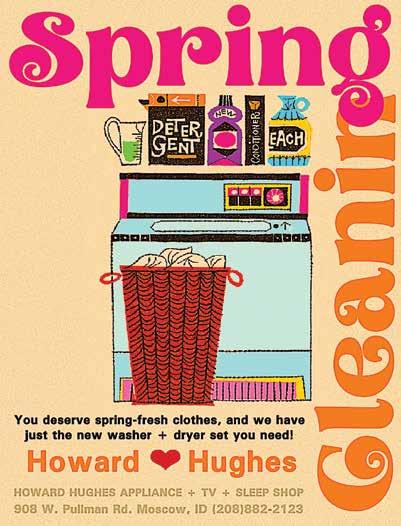
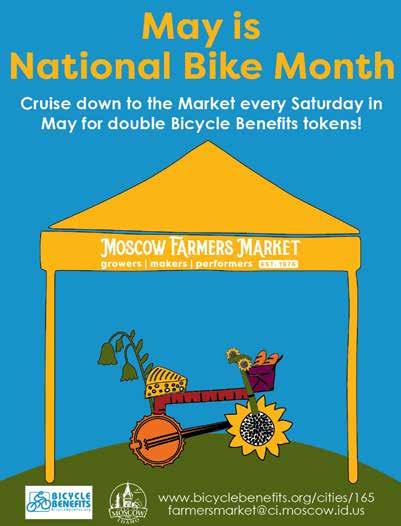
The chicks have been a nice distraction to what has become a real slog getting my long-awaited dream greenhouse project finished. After my last writing where I shared my journey in choosing the right greenhouse features for me, I went ahead and made the on-line purchase. And then I made the mistake in December of telling friends what I got for Christmas, well they asked, and that it was a greenhouse. Since then, is has been a constant flow of inquiring, “Is it done yet?” which I can tell you is as annoying to a late-middle aged man as, “Are we there yet?” to a young-aged man. Nobody wants to get there faster than me, okay. Of course, I have been working on it between long weeks at work, snow storms with arctic temperature blasts, and too many other projects. The prep work has been way more than I anticipated. As any hobby farmer will tell you, projects that we dream up somehow turn into work. The bigger the dream, the greater the work. In this case, a simple leveling project to create a flat pad for the greenhouse turned into a two-foot high, twenty-six by twelve-foot-long hand-set rock retaining wall filled with three separate two-ton loads of gravel and a chaser two-ton load of sand, all nicely packed with an evil compacting machine. All that, finally topped with two pallets of pavers. Just like Con with her chicks, getting my greenhouse up and going has turned into a real labor of love. I described in last month’s submission in Home&Harvest, my thought process for choosing the site for my greenhouse based on good spring sun exposure with just the right amount of summer shade to keep it from turning into a sweathouse in August. The prep work has been physically draining, so when it arrived in all of its brown-box glory, I was giddy. I remembered my twelve-year-old self on Christmas Eve receiving the pinnacle of a 70’s-kid’s Christmas gift; a sparkling blue Kawasaki motorbike! But the excitement faded in the weeks to come with feet of snow on the ground. As with my greenhouse stacked in boxes, all I could do was wonder what it would be like to ride that bike. When the day did come to try it, I couldn’t get it started. We had to load it up in the old ’65 Chevy and take it to the dealership for a starting tutorial; turned out my dad and I were over-choking it. Back home she finally fired up, belching sweet clouds of two-stroke exhaust and I then spent two more days popping the clutch and tipping it over because I was “supposed to grow into it.” I did eventually and what followed were years of total pleasure as I explored nearby hills and valleys on that motorcycle. So, it has been this winter that I could only go into the shop and peek into the huge boxes of Lexan and powder-coated aluminum parts accompanied by a dizzying array of bolt, nuts, washers and screws all waiting for the weather to improve, so I could finish the pad for the actual greenhouse assembly. I hope to get as many years of pleasure out of my greenhouse as I did that little Kawasaki motorcycle! Greenhouses have sure become the rage and for good reason, so I know my trials are going to be worth it. Maybe it is just me, but I am seeing them being sold everywhere in all sizes, shapes, and compositions. All the “cool kids” are getting one. I almost feel like I might get some special invitation to join an elite club or secret greenhouse society which is a relief. I’ve always felt insecure not having a greenhouse. People seem to want to know if you have a greenhouse when they find out you garden on a larger scale, so I just started admitting my shame like some sort of introduction at a self-help group meeting. “Hi, I’m Trent. I’m a gardener and I don’t have a greenhouse.” I’ve decided I’m going to stay very humble about my new greenhouse now that I have one. I probably won’t bring it up unless asked and certainly won’t brag on how big it is; no need to be offensive or anything.


Of course, just because you have a greenhouse doesn’t mean you can grow things in it with great success, so there’s that. I want to make sure and keep that “growth” mindset and not get too cocky. So, what does go into a good greenhouse set up?
I did serious research before purchasing my structure and visited some local commercial operations. As previously discussed, I was also assisted by a knowledgeable greenhouse vendor at an on-line store that carries a large variety of products nationally and even internationally. Sure, it may be convenient to purchase one locally and there are lots of great options to choose from, but I would encourage you to make your decision in part in a similar context to that little broody Con I earlier described. The structure is only the start. Germinating plants from seed is not that much different than what a good mamma-hen naturally does to bring new life to what might otherwise end up a breakfast omelet. While a greenhouse may be green (or another “earthy” color) and shaped like a house, this does not mean it possesses the elements needed to have real success starting and cultivating annuals in the spring or sustaining perennials during winter snow. Consider this: for many years, we helped our young daughters hatch farm-laid and fertilized eggs in an incubator, and it does work but not as well as a good brood hen. Our incubator came in two parts: the tilting egg tray and the humidifying mechanism which worked okay unless we neglected it for a day or two and then the hatch rate would plummet. My sense was that a hen will hatch nearly all, if not one-hundred percent, of the eggs she sets while I would bet going the incubator route gives you an eighty percent hatch rate. In doing some research, I found that is accurate, and it makes sense. I knew that a good brood hen plucks her under feathers to allow her warm skin to touch the eggs. I also knew that she will rotate and turn them every few hours and not allow temperature or humidity fluctuations critical for embryo development. What I didn’t know is that a good broody will only set on eggs she knows are viable. How do they know? She also knows to somehow increase ventilation to the eggs as they mature as more oxygen is needed to permeate the shell, as well to let carbon dioxide escape. Temperature consistency, humidity, oxygen/C02, and ventilation… Are we talking about chickens or greenhouses here? YES.
I paid a bit more for my greenhouse but with full walls being Dual Pane Lexan (polycarbonate), I know that intense direct mid-day sun rays will be diffused while on cooler lowlight days, I will get the benefit of maximum ray exposure. It also came with a sunscreen shade-cloth to hang as summer rays intensify. For temperature control on hot days, it is set up with a thermostat activated outflow fan set near the roof which when activated will open two vents placed low on the opposite end of the structure, allowing cooler air exchange. On cold nights two made-for-purpose heaters will kick on, so I won’t be sweating cold snaps putting a stop to growth. I can use the French door when I’m home to help with airflow as well. With temperature and ventilation covered, I now must factor in humidity and this model came with an easy-to-assemble misting system complete with timer. Finally, it came with two full-length, matching aluminum benches, so I won’t be trying to retrofit working and potting spaces. The total overall robust aluminum frame bolted together and anchored to my shop and the concrete floor will offer great strength in our spring windstorms. Having it bolted to an existing stable structure will also help. I used pavers placed on sand and gravel to allow for water to escape as I hand-water. These features are considerably more than what comes with most greenhouse purchases but are aspects you may need to consider for good success. Your purchase or construction can be retrofitted in many ways and in any size. The goal in all of this is to assemble a sturdy space with an internal environment for seeds to germinate, which requires a consistent temperature of around seventy to seventy-five degrees, depending on the type of seed, with a humidity of fifty percent. Oh, and don’t forget to start with sterile soil. Your well-considered greenhouse will also provide a safe place for germinates to continue their maturation with the heat, safety, airflow, continued humidity, and light until the time is right to move them outside, if that is your aim.
I hear the tell-tale cheeping of one of Cons chicks lost in the field separated from its family and I am reminded that no matter what she or I undertake in growing this spring, the next generation of plants or animals on the farm will have risk and a learning curve. Whether you have a greenhouse, are getting one, or start the beginnings of your flower and vegetable garden on the sill of a French window in your kitchen as I did for years, I wish you all the best. Spring is on your side. Enjoy!
Home&Harvest | March+April 2024 53
A Reading for You
by Annie Gebel

For this issue I’ve chosen a deck I haven’t used here before. The Unfolding Path Tarot by Athene Noctua was posed with the question, “What message do readers need to hear, to feel deeply, that can empower them this spring?” I invite you to ask yourself the same question, take a look at the cards and choose the one you feel holds your message.
2 of Wands
Is it time to go? Is it time to go deeper to go further to go it alone? Maybe not yet, but it’s getting close and it’s time to get excited about it! This card is about preparation and planning and it often points to travel but could be referring to a journey of a different kind. It could also mean that you’re meant to look in a different direction.
Let yourself take to heart that you have the knowledge and resources to make the plans that you’ll be able to put into action in the future. Adventure awaits and you’ll be ready when you reach its threshold.
VIII Strength
This is a major arcana card, which I often think of as a ‘sit up and take notice card.’ Their messages come with a little more umph, if you will. The Strength card is about a deeply grounded and balanced sense of power.
You’re being called to remember that in yourself. If you’re feeling the kind of strength course through you that’s akin to anger or control, get curious about the source of or reason for those feelings. Curiosity breeds compassion and that compassion will balance your strength into a more gentle, resolute strength. If, instead, you’re feeling meek or you recognize that you’re lilting in the face of others, remember that the lion may laze through most of its day but its roar is impressive.
The strength that this card is calling forth in you is resilient, composed, graceful and always rooted in love.
Queen of Cups
If you read the last card’s interpretation, you’ll already know the phrase ‘curiosity breeds compassion.’ I’m using it again with this card. To be honest, I use it often - it’s a really good one! This Queen is at the top of her compassion game, and that includes toward herself. We can find it easier to be loving and forgiving toward others, yet the way we talk to and treat ourselves can be harsh or even hurtful. You’re being invited here to choose compassion for yourself too. Be curious about the recurring hurtful thoughts you have about yourself. Be forgiving about the choices you made before you knew better. Be congratulatory about the ways you’ve done better once you’ve known better. Find something you’re confident in or about and celebrate that for yourself.
Treat yourself with kindness and compassion, like this Queen. Don’t let the negativity of others get you down. Find the source of your intuitive wisdom and feel the love that comes from that place in you and let it fuel your confidence. This Queen is definitely reminding you to own your empowerment.
x b x
Home&Harvest | March+April 2024 55
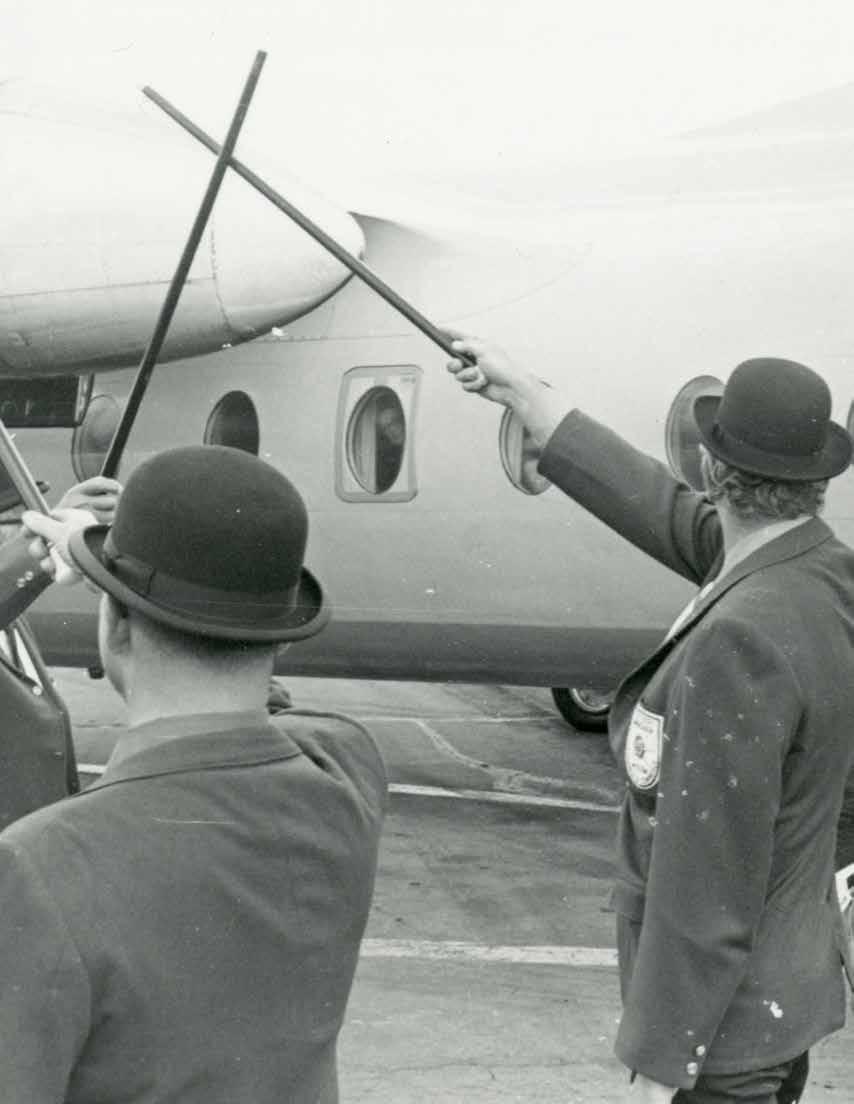
Up, Up And Away
Kaitlynn Anderson by

When thinking about the Palouse, several images come to mind. The rolling hills of green fields and crops being harvested. People greeting each other and seeing familiar faces everywhere they turn. Farmer’s markets, festivals, two land-grant universities, and historical downtowns and homes. However, one aspect of the Palouse that stands out in juxtaposition to the landscape is the Pullman-Moscow Regional Airport. Albeit small in size, the commercial airport is an unforeseen structure most would not expect to see while traveling through the winding roads and hills. The presence of the structure begs the question of how the idea to add an airport in the Palouse transpired, as well as the use of airplanes within the region. These questions and answers are important to understand how today there is a new airport terminal being built down the road from the current terminal.
It was evident that airplanes played a large role in the agricultural scene within the Palouse, as well as a fun hobby for some. With planes serving both recreational and operational purposes, what was the reasoning for the current terminal? Were there enough people to utilize a commercial airport, or were private flights sufficient for local and visiting flyers? In an attempt to determine the answers to these questions, we must go back even further to when airplanes arrived in Moscow and how they were used.



Assisted living apartments available 208-882-6560 640 N. Eisenhower Moscow, ID 83843 208-882-6560 paradisecreekrl.com Live at a place where friends become family! Call today to nd out about our spring move in specials. 208-882-6560 At Paradise Creek Assisted Living, you spend time with friends while we give you a helping hand with your daily to-dos.
It is no secret that the wonder of flying was on the minds of individuals throughout the world. Once the Wright Brothers were first in flight in 1903, similar models were created throughout Europe and Canada, but none of them were as successful as the Wright Brothers’ handiwork. It was not until years later when Orville and Wilbur held public flying events in Europe that people began to fully realize that the future had arrived.
The Palouse was no exception when it came to utilizing the new invention. During the 4th of July celebrations of 1911, aircrafts would fly in to show off the skills of the pilot by doing barrel rolls and flying upside. Individuals would line up to ooh and awe at the tricks pilots would display, which led to some folks becoming highly intrigued by flight and airplanes. A few locals began to create home build airplanes, which is essentially as it sounds – building an aircraft from scratch from the comfort of your home or at a hangar. Although some of these planes appeared to be functional, some of them never even left the ground for flight. Similar to participating in other hobbies together, home builds could serve as a bonding opportunity for families and friends, while also challenging the technical skills of individuals. Aside from the tricks and home builds, locals utilized airplanes for more practical uses – agriculture. Planes allowed farmers to better take care of their crops and view their land from a new perspective. Crop sprays could be attached to the wings of planes, allowing farmers to effectively fertilize and protect their crops from pests. It was no surprise that planes were a new tool for several of the farmers in the Palouse.
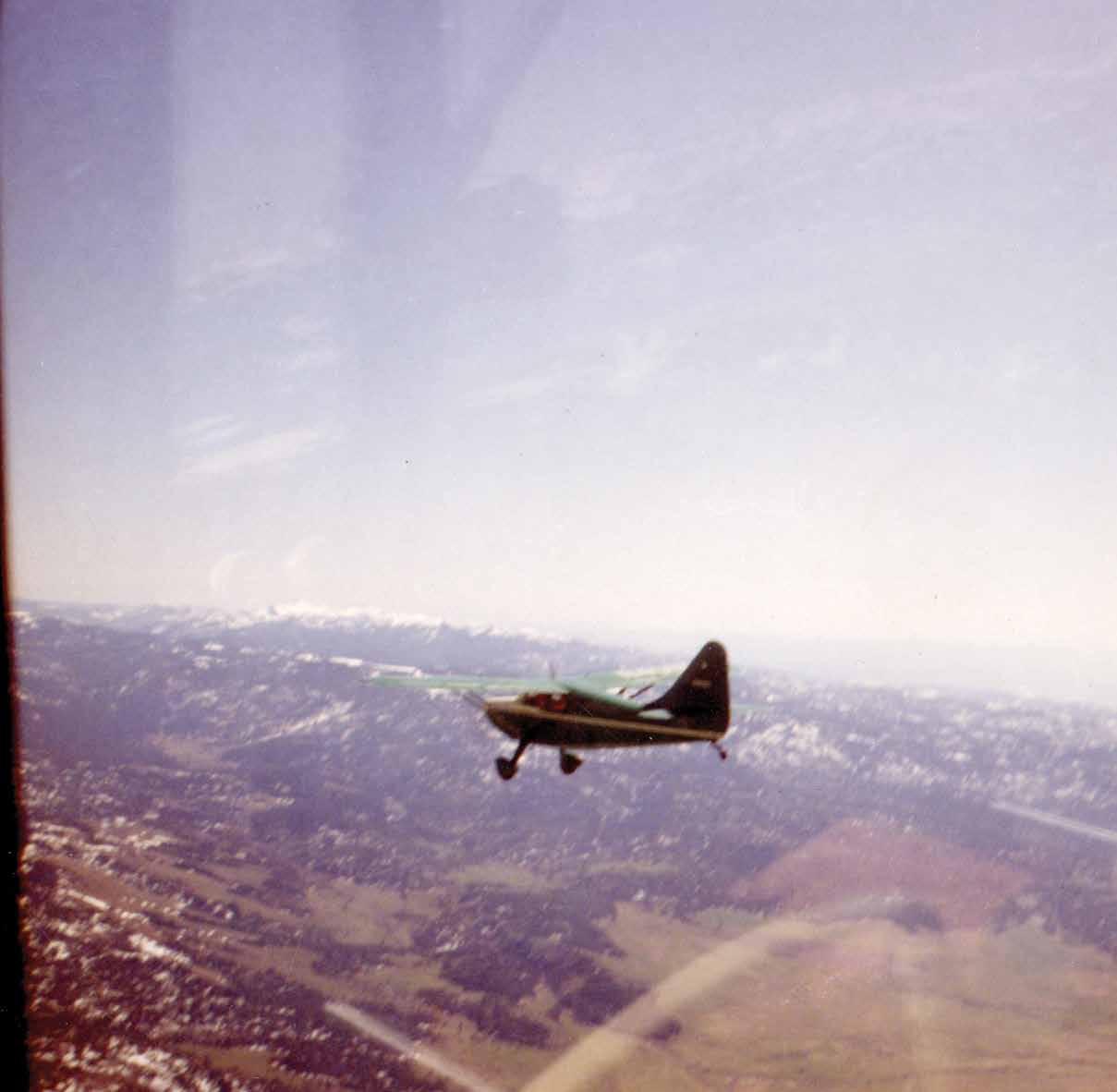
As the number of airplanes in the Palouse increased from the 1910s to the 1930s, it was evident that a dedicated space was required for the planes to safely come and go. Until 1932, a dirt landing field a mile north of Washington State University was utilized by many of the local flyers. The landing field served as the closest thing to an airport in the area, which made it a high-traffic area. It was at this time that the idea of building a local airport was created. Three main reasons supported the creation of an airport: an increase in security concerns, community belief that an official airport was necessary, and the current landing field not being able to meet the needs of incoming visitors for a Washington State College football game. Five potential sites were reviewed, with option two, where the present-day Pullman-Moscow Regional Airport, was selected. This location was ideal due to the number of approaches it provided, however, the road in the area would need to be rerouted. In 1934, fifty acres of land were purchased from the Whitlow family and Nellie Courtney. As the project relied heavily on federal resources, especially during the Depression, the Civilian Conservation Corps and the Civil Works Administration aided in the construction. Unfortunately, federal aid was removed, leaving the airport unfinished. After years of communication with the Pullman Chamber of Commerce, Washington State College, University of Idaho, and local officials, the airport officially opened between 1940 and 1941. For the opening, over 5,000 people attended, as well as a long line of around 200 cars.






Join us for a Fundraiser and help build the 2024 Habitat home in Moscow!
Online Auction
April 13-20, 2024
palousehabitat.org
In-Person Event
April 20, 2024
SEL Event Center


As the years went by, changes were made to the airport. Drainage was added to the airfield, the runway was expanded, and a new terminal was added. These changes were important as they allowed for safer flights and increased travel to and from the region. The new visitors to the area did not go unnoticed by the communities. The Moscow Chamber of Commerce Ambassadors often would greet individuals at the airport when they landed to welcome them to Moscow. Another group was formed by the Moscow Chamber of Commerce Aviation Committeethe Flying Pea Weevils. Being formed in 1964, the purpose of the group was to tour Idaho to promote Moscow and the University of Idaho. Suffice to say that their efforts were beneficial.With the size of Moscow and Pullman growing over the years due to new residents and higher enrollments at the universities, the demand for more flights became prevalent. In order to solve this so-called positive problem, a new terminal was required. The new terminal was one of the components of the Pullman-Moscow Regional Airport capital improvement plans. Realizing that the new terminal would allow for an increase in incoming and outgoing flights, this meant that an expanded runway was necessary. The expanded runway project began in 2018 and opened for use in 2019. Another one of the major tasks to complete for the improvement plan included the new terminal. Beginning in 2022, the ground for the new terminal was broken. Several factors played into a new terminal being included in the improvement plan. Between airlines switching to jet service, the addition of new flights, and an increased number of travelers, it was clear that the current 8,785 square foot terminal would no longer fit the present and future needs of flyers. The new terminal is projected to be 47,500 square feet with amenities including a restaurant, new baggage claim area, courtyard seating, and over 450 parking spaces. Perhaps from the courtyard area, you can delight in the scenic view of the iconic rolling hills of the Palouse while enjoying a meal from the new restaurant before or after your flight.
With this brief timeline and history of airplanes and the airport, it is unmistakable that they have left their mark on the Palouse. Students from all over the world can attend either university, visitors from near and far can fly in to visit family members or athletic events, and private pilots and medical services all serve as a few of the notable benefits of the airport.
As the May 15th official opening date for the new PUW terminal draws near, are you excited to see all of the new amenities that it has to offer? Have you already booked a flight to enjoy the new jet bridges? Are you eager about the new possibilities the terminal has to offer? The potential for increased and improved travel, increased visitors to the Palouse, new students at the universities, and economic benefits? Or does the sound of less parking in town and crowded streets make you weary? Either way, the new airport terminal is here to stay and will bring a variety of heightened elements already present in the Palouse. For more information on the history of airplane uses in the Palouse and Pullman-Moscow Regional Airport history, visit the Latah County Courthouse to view the accompanying exhibit. Additionally, if you have any stories related to the airport or flying within the Palouse, LCHS would be interested in conducting oral histories to add to our collection. HERE
FOR YOU, NO MATTER WHAT.
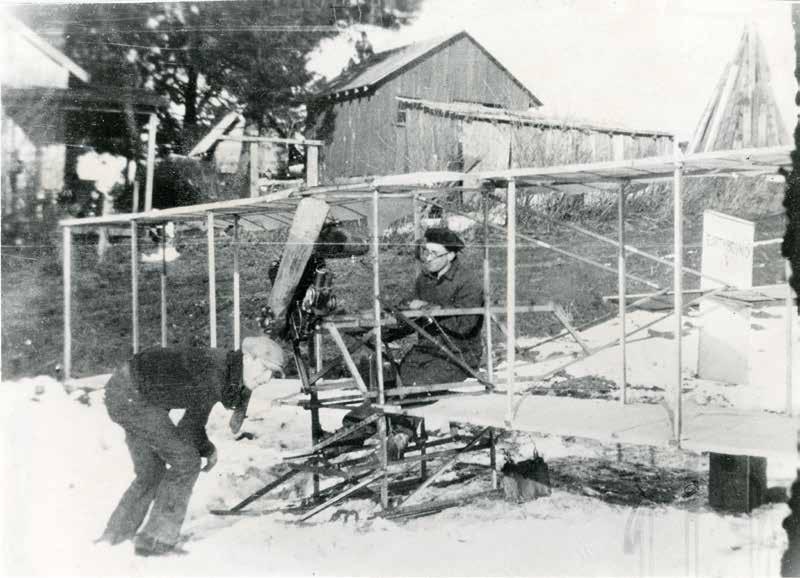


New Nest in Town
BY sandra S. Lowther

Bring all your Friends Free!
It is 2017-The Year of the Grand Design.
I live in a small town eight miles from the two-state cities of Lewiston, Idaho, and Clarkston, Washington, where the Clearwater River merges into the Snake River at what we call The Confluence. The Snake River continues to join the Columbia River, which eventually flows into the Pacific Ocean some 400 miles downstream. This vital waterway is a natural and historic artery that supports wildlife, tourism, and agricultural shipping in our region.
From my home on the banks of the Snake River, my husband, Jim, and I have a panoramic river view and enjoy the wildlife that wander between the river and our house: deer, fox, birds, raccoon, and an occasional skunk. But bird watching is our favorite sport. Our clean, clear, broad river provides plenty of fish to sustain birds of prey. My heart swells when I spot a majestic bald eagle in the sky. The more slender ospreys begin to arrive each spring from their long winter migration. In past years, local osprey pairs have established four or five nests along our river. Jim and I keep tabs on these sites during our frequent walks. Since it is late winter, all nests are vacant.
A few years ago, our next-door neighbor, Noel, installed four wood duck nesting boxes along the river behind his house. A commissioned sign reads Wood Duck Habitat-Please Do Not Disturb. The male duck is a favorite of birdwatchers. He is fresh out of a graphic design studio. White lighting bolts streak down his neck to the shoulder and border his red chest and rump. Topped with a greenish purple head, red bill, and red eyes, he is a gift to the beginner birdwatcher. The female has a gray body and black eyes. It’s St. Patrick’s Day. The wood ducks are busy at Noel’s nesting boxes. Think of them as our Irish ducks, a harbinger of spring. Yellow sprays of forsythia appear in the yard across the street. The buds of the dogwood and magnolia trees are plumping. The tips of my daffodil foliage peek through the winter’s duff- all signs of warmth and renewal. I received three seed catalogs in the mail last week—time to check my seed inventory and plan this year’s vegetable garden. The ospreys will be here any day.
A steward of the common ground between our houses and the river, Noel mows a wide swath, providing smoother access. Each day, he walks his dogs, Ellie and Abby, visits with other folks, and keeps a pulse on the local wildlife. He shares his first sightings and unusual happenings, such as the mule deer doe that attacks his dogs. Noel shouts and waves his arms. The doe turns on him. Knocks him down. The deer retreats only when other walkers come to his rescue. They spot newborn twins bedded down in the riverside weeds. This explains the mother doe’s rare actions.
Like the folks in Capistrano, we watch and wait for the ospreys’ return. It is late March when we hear the piercing whistle of the first bird of the season. Finally, the ospreys have arrived from their long and arduous winter journey. The birds celebrate the return to our skies; catch currents, dip, and dive with exuberance.
I am inclined to own, to enfold, to humanize nature. It’s like when we return to our summer cabin after a hard winter. We find that the roof needs new shingles. The front door sticks, and the gate hinge needs replacing. We make a trip to the hardware store to gather supplies. There’s work to do. It is the same for ospreys. Spring is nest maintenance time. They make repeated flights, bringing small branches, sticks, and weeds to the nest, which looks like a child’s game of pick-up sticks, a free-art form structure. It is documented that they haul in plastic bags, hay-baling twine, a jumble of mono filament fishing line with a hook still attached, and even small toys. These are dangerous additions, as the birds can get tangled in the mess.
In the mid-spring of 2017, Noel reports that an osprey is building a nest atop the cross bars of a utility pole near our small town’s boat ramp. A few days later, a power company lineman removes the nest sticks and places a goose decoy atop the crossbar. This is intended to discourage any future osprey nesting efforts. Noel decides that he has an ideal site for a new nest platform: the area between his house and the river. This nest location can provide the ospreys a 360° view, plus an unobstructed takeoff and landing base. Perhaps the evicted boat ramp bird can relocate. As a bonus, Noel will have a prime view of the osprey’s activities.
Noel shares the scheme with his son, David and us. Can we make this happen? The group hearkens back to their physics and engineering experience. Jim produces a yellow print (a design drawn on a-
Room at the Top Stay all Summer
* * *
* * *
* * *
Home&Harvest | March+April 2024 66
R
-yellow legal pad) demonstrating how he and Noel can use ropes and a winch to lift the pole. Yes, they like the idea. David can get a utility pole. Jim agrees to build the nest platform. Noel will dig the hole. I’ll help when I can and take photographs. Team Nest goes into action.
David contacts the Fish and Wildlife Department. They provide and deliver a thirty-foot utility pole to the river side of Noel’s house. Noel begins digging. Once the hole is deeper than his shovel handle, he attaches a coffee can to the end of a broomstick handle. With this tool, he can reach the bottom of the hole, bringing up the last remnants of sand and gravel, one coffee can scoop at a time. He intends to dig the hole six feet deep but stops at five when he hits the water level.
Jim Googles “How to Build an Osprey Nest Platform.” It must be strong enough to support several birds and the accumulated nesting material they add each season. He uses twoby-six-inch treated lumber to construct a four-foot square base. He lines the frame first with hog wire, then chicken wire. A cross-section pair of boards braces the underside. The platform attaches to the pole at the center of this brace. Next, a pair of two-by-fours is bolted to one end of the support and serves as an angle brace. Later, these boards will be attached to a point a few feet from the top of the pole. This platform is robust, airy, and as light as possible. He adds a sturdy perch support off one side of the platform. Jim ties a few husky “nest starter” branches atop the wire base for icing on the cake. The components are ready. Now, how do they get the butt end of the pole started into the hole? Over several evening beverages, there is some head-scratching and a review of essential physics, vector force, fulcrum, lift, and leverage principles. The group refers to Jim’s sketch. In our family, this is called a yellow print.
The following day, Jim and Noel attempt to move the pole. It is too long and heavy for our small crew and rudimentary equipment to manage. We wives support this project but are anxious about the possibility of someone getting hurt. Ellen and I stay nearby; ready to call for help if anything goes wrong. The men cut five feet from the bottom end. Noel ties one rope end to the top of the pole; Jim ties the other end to the winch attached to his trailer hitch and successfully drags the tip downward. Now, the pole’s butt end rests on the edge of the hole. Recent high water has left the ground near the river soft. Jim’s rig gets stuck. This was outside the plan. We all have a chuckle at this predicament. Noel retrieves his SUV and parks it on solid ground to serve as an anchor. Jim attaches his winch to Noel’s bumper and pulls himself free of the muck. After a short break, the men lift the tip by hand while I place four concrete blocks under the shaft. The men bolt the platform to the top of the pole. Planning ahead, they use slip knots to tie the ends of two 100-foot ropes to the pole, six feet under the platform. Once the lift is complete, a strong tug on the slip knots releases the ropes. To prevent the butt end from sliding beyond the opening, we insert a two-by-six-foot piece of plywood into the uphill side of the hole. Noel and I stand perpendicular to the pole, each holding tension on our rope to stabilize any side-to-side lean. Jim ties a third rope from the pole to his winch. Now, he has a straight pull. The whole unit is ready to raise.
Ellen brings lawn chairs, soft drinks, and cookies to a safe viewing area. Several neighbors have gathered to witness the grand erection. The pressure is on Team Nest.
Jim activates his winch; however, because of the contour of the ground, the pole skids vertically rather than lifting. Work halts. Heads are scratched. The tip section needs to be higher for the winch-pull triangulation to succeed. Noel calls a neighbor, Dave, who drives his small tractor to the site. He positions the tractor’s front-end lift under the upper shaft of the pole. A slight upward nudge accomplishes the angle needed. Noel and I take our rope positions. In concert, Dave and Jim operate their respective lifting mechanisms. Oh no! The rope slides in my hand. I lose my grip! Once again, Dave comes to the rescue. He ties my rope to his lift and pulls the pole back into position. Jim resumes lifting. Vector force, weight, and gravity bring the pole to a vertical position. The butt end settles into the hole. The spectators cheer. Everyone grabs a shovel and throws dirt and gravel around the base. Mission accomplished.
We all know it is too late to attract any birds this season. We are confident an osprey pair will occupy our superb nest next spring.
It is Spring of 2018. Oh, woe is me. Not one osprey has adopted our nest. Nor does it happen the following spring. Do we need improvements? A remodel? Jim weaves a four-by-fourfoot mat of willow branches. An acquaintance of Noel’s drives his lift bucket near the pole and puts the mat on the nest. Dove, ravens, hawks, and dickey birds enjoy perching on our platform. No osprey is inclined to stay.
A local sign craftsman mounts a welcome sign on the pole at eye level, that is, human eye level: Room at the Top Stay all Summer Bring all your Friends Free!
We realize osprey can’t read, but the sign looks nice. The nest may need to be higher. The men regret cutting five feet off the pole. Why didn’t we install a nest camera when the bucket lift operator was here? We are in our early 80s. We hope we live long enough to see this nest occupied. Jim wanted ladder steps on the pole to access and maintain the nest. I am glad there are no steps.
Nevertheless, we enjoy the osprey in our area as they soar over the river, fold their wings, go on stoop (dive like an arrow) into the water, and, in a cascade of droplets, lift into the air clutching their fish dinner. The osprey’s four opposable toes, sharp talons, and spicules on the under parts of the toe pads enable the bird to grasp and hold slippery fish.
We watch birds glide close to the surface, angle their legs downward, and drag their talons through the water as if washing them. Occasionally, midair antics result in pairs flying close, jousting, and fighting. Flirting? Their interaction is erratic, confounding, heart-stopping. A pair tumbles through the air, separating in the sliver of space shy of the water’s surface. A courtship maneuver? We hope so.
People ask me, “How can you tell an eagle from an osprey?”
“What are their differences?”
* * *
*
*
*
* * *
Home&Harvest | March+April 2024 67
WE GETAWAY TO COME TOGETHER

Three rivers and seven wilderness areas meet in Missoula, Montana, a place of small-town charm and big city personality packed into one magical escape. Nature and culture seem to coexist in perfect harmony here, where public art and outdoor concerts feel as natural as the surrounding mountains. Missoula offers a chance to rest and recharge, inside and out. Sit back and be well in this cultural hub and culinary hot spot, and soak in the serenity of some of the world’s most soul-stirring landscapes.
Travel Safely. Explore Responsibly. Call 1.800.526.3465 or visit destinationmissoula.org/hh for more information. Safely.
CLARK FORK RIVER, DOWNTOWN MISSOULA
A mature bald eagle has a dark body, a white head and tail, and yellow legs. It can weigh fourteen pounds and has an eight-foot wingspan. Eagles prey on small birds, snakes, mammals, and fish. Their preferred habitat is conifer forests, where they build large cone-shaped dwellings of natural material. The osprey is also called a fish hawk, river hawk, or sea eagle. Ninety-nine percent of their diet is fish.
Weighing in at three to four pounds, with a wingspan of five to five and a half feet, they are the smaller bird. Osprey have a white head and body. A dark band runs across the eye to the shoulder of chocolate brown wings, mottled with lighter spots. They are aviators extraordinaire and can lift and carry half their own weight.
Ospreys are comfortable nesting in urban areas and are not bothered by human commotion. Their nest might be in a tree snag, on a utility pole, or atop an artificial platform, as long as it is near good fishing waters. My town has several osprey nests: two on frames atop two of the stadium lights at the school’s sports field; three man-made platforms along the river’s edge.
Though ospreys, herons, and eagles compete for fish, I spot fewer eagles while ospreys are here for their breeding season. I did witness one osprey drive a flying blue heron down into the water, a warning to that competitor.
I look up from tilling my garden when I hear the osprey call. I aspire to fly with these splendid beings. To soar, ride the air, to hunt. I wish them success. One glides away from the group and stalls. Makes a slight adjustment – a flutter of feathered wingtips. Focused. Suspended. Poised for the dive.
I am transformed in an instant. The air flows across my white chest and enlivens my plumage. I am Osprey.
I dive, pull up, dive again—display for my mate. There is a silver flash in the water. I commit, fold my wings back, and dive. Shy of the vital plunge, I unfurl my wings and throw my legs forward as I hit the water. I am a ragged mishmash of submerged feathers drifting with the current. Give me a moment. I shudder. Make a few half-strokes to steady myself and dip my head underwater. Rotate and clamp the struggling prey. It quiets. Quits.
How much energy will it take to lift this catch? I’m ready. I compel muscle and grit. Unfurl my wings. Give a mighty leg thrust. I am away into the sky, carrying my prize. I shed unnecessary cargo with a wet dog shake. My feathers cast crystal water droplets, beads shimmering in the sun.
I make a transitory stop at that new platform to rest and enjoy my meal. Before leaving, I raise my butt and shoot out a large stream of white poop—a taunt to the audience of spies. That shocking blast of excrement through the air pulls me back to reality. I squint. Am I insane? I shake my head. I am stripped of feathers, garbed in my mortal husk. Leaning on a rake handle. It’s back to tilling the garden for me.
The year is 2023. It’s been five no-bird years, an ongoing disappointment. Our lives go on. We hunt mushrooms in the nearby mountains, plant our garden, pick wild blackberries, and always check our platform. Then, early in April, an osprey lands on our nest and stays awhile. The bird is back, fish in talons, lands on the nest perch. He is both savage and delicate as his hooked beak tears into-
-his meal. Comes again, this time dragging a branch or two. Our bird hotline goes berserk. We are thrilled. Over the next few days, he returns repeatedly and stays longer each time.
I named him Hallelujah as he arrived on April 9, Easter Sunday. A second bird, likely a female, arrives a few days later. I call her Jubilee. Hallelujah and Jubilee understand our sign. This pair is into serious nest building.
Both birds make incessant trips to the nest, bringing twigs, branches, string, and even a giant tumbleweed. They repeatedly mate on the nest, fly in big circles over the river, make dramatic dives, joust with other adults, and defend their nest. None of us can distinguish male from female, but it’s time for egg-laying. Soon, one bird remains in the nest. The other bird—this is Hallelujah – brings fish to the perch, pecks a few morsels for himself, and shares the rest. He hauls in more nesting material. We become proprietary. Our nest. Our osprey.
Jim and I leave on a three-week vacation. Noel logs April 12 as the start of the brood and sends us regular bird updates. It slips his mind that I named the birds when they first arrived. Noel calls them Bob and Betty. Absolutely no originality in those monikers! I’m sticking with Hallelujah and Jubilee, Hal and Jewels.
Glad to be back home, we enjoy seeing our osprey cooperate. Hal continues to guard and bring food to his mate. Jewels stays “on brood,” never leaving the nest.
As sunflowers turn to the sun, we arrange our indoor and outdoor chairs facing the nest. Watching these birds is better than watching TV. Egg incubation takes 35 to 40 days. More waiting is in the store for us. Friends are curious. Inquiries are constant. How is your osprey? Are there any young ones yet? The excitement builds.
It is typical for the female to lay two to three eggs one to three days apart. The eggs hatch days apart. The first hatchling develops quickly and has an advantage over the younger sibling. The first-born brute can be fatal to the second or third-born chicks.
It’s June 14, and Noel reports seeing a tiny head. We rush to our binoculars and spot a small beak under Jubilee’s feathers. What a thrill! We’re bird grandparents! The next day, a second baby appears—a double joy. Since our birds hatch one day apart, it increases the chance that they will both survive. The chicks are spindly, the size of a tiny fist. Their birth down soon gives way to soft feathers similar in color to those of the parents but with less distinct pattern markings. At least one parent guards the nest. When a hailstorm passes, both parents are on the nest; their wings spread, shielding the young birds. The roar of unmuffled race boats during the Thunder on the Snake event does not scare the parents away from the nest. Nor do the bursts of noise and lights on the Fourth of July. Only a mowing machine circling the base of the nest pole drives both adults from their post, but only briefly. These are incredible parents.
Hallelujah has two more mouths to feed, so the pressure is on. He hovers, spots a fish, dives, and extends his feet and talons-
* * *
* * *
* * *
* * *
* * *
Home&Harvest | March+April 2024 69
-at the last moment. Hits the water with a splash. His oil-infused feathers allow him to stay submerged until his prey is secure. Drops cascade off his body as he lifts from the surface. He positions the fish’s head forward in flight, an aerodynamic package. The fishing action is repeated throughout the day, every day.
Hal is an accomplished fisherman who must defend the nest against nefarious threats. A lone male osprey challenges Hal in the air above the nest. Our bird community also includes owls, eagles, hawks, crows, and ravens, all looking for a free lunch. Along comes a raven who, at maturity, weighs about two and a half pounds and has a four to four and a half wingspan. This strong, aggressive bird can drive an adult osprey from the nest, leaving the chicks vulnerable. The raven spies a fish carcass on the nest. His invasion may leave fledglings maimed or dead. Hal drive the raven away. Both parents must be alert at all times.
Each time Hallelujah brings fish to Jubilee, she tears small bits and, with great care, feeds their fast-growing young. Parents fold their sharp talons into fists while moving within the nest.
Chicks soon learn to stab and tear a fish meal for themselves. They double in size over the next few weeks. Ospreys are far more vocal than we expected.
The nest is noisy and bulging with birds. The young approach the size of their parents. I cannot tell them apart. Adults perch on the edge of the nest and stretch their wings as if to say, Do it this way. Fledglings mimic parents. Like those early flying machines, they pump their legs, flap, and make tentative hops. We cheer when they dare to hop from one side of the nest to the other. Young wing hits another young’s head. It is a frenzy. At times, it seems the whole nest might lift from the pole at any moment.
I find myself glued to the binoculars or sitting on the chair with the best view of the nest. It is an enthralling time for me. I venture to say it is the same for our osprey family. By late July, short test flights occur. Gone and back. Repeat. During the night, all four birds are in the nest.
Jewels is the first to fly south. Her job of bearing young this season is complete. Hal continues to bring fish to the fledglings but spends less time at the nest. A few weeks later, he leaves.
The teenagers hop about the nest. Make beg-calls to no avail. I don’t see them catch fish, but they put on bulk and flit around the nest and in the surrounding air. Fly and joust with their peers. Typical. Gone and back. Gone and back. Gone.
Have a good trip south. I will have my binoculars ready when you return next spring.



Crosstrek Wilder ness Adventure on the edge.
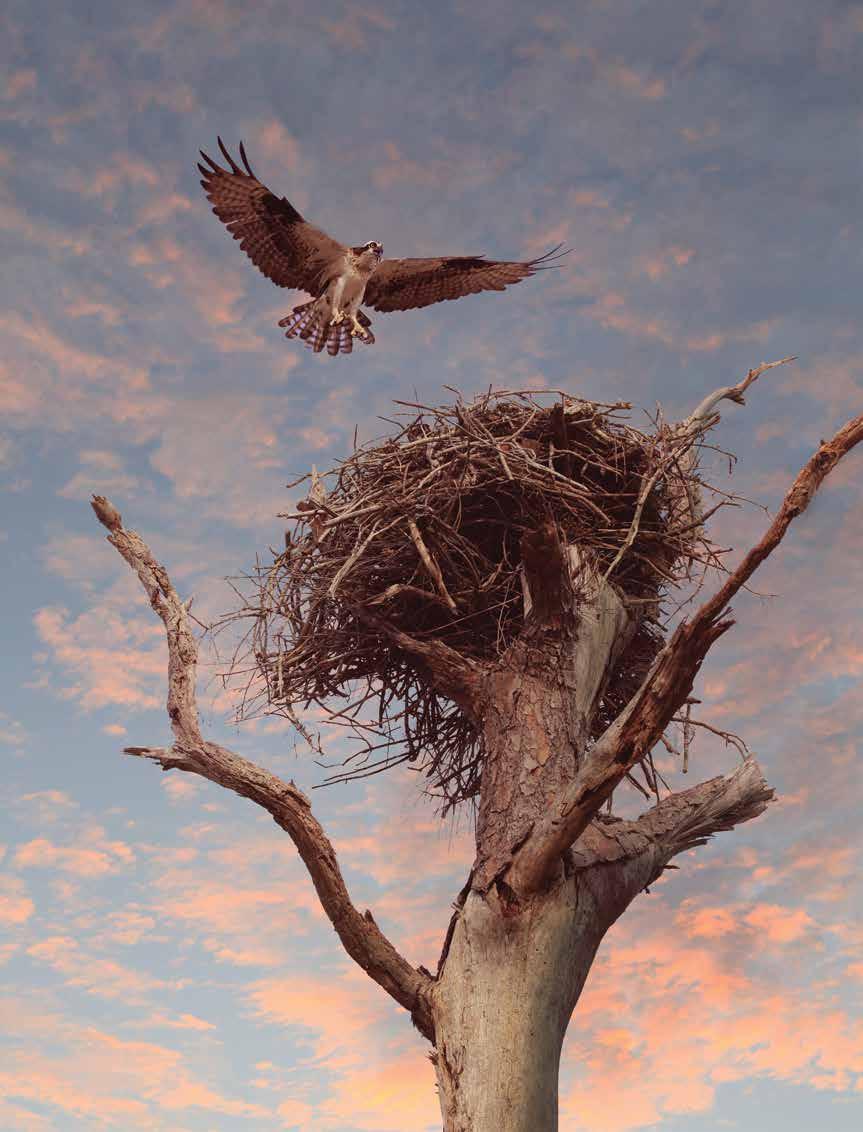

I had the most amazing dream the other night; I met you, and we were home.
I can remember every little detail. It was a normal day at the shelter. I’ve been here a very long time, many years. I’ve had so many great memories but every day I wish for the one thing every dog dreams of: to hear my owner walk through the door, and to just know it’s them by their smell. That’s how my dream started- I smelled YOU!
You said, “Kaya, you are my baby! What a good girl!” and I wagged my tail so hard I thought it would come off! You bought me a leash already- my own leash! And after we got to go to the best room- the adoption paper room, I said goodbye to everyone, and promised this time it was for real. Walking through the halls was like a dream. “Is that Kaya’s family? Finally- a home for Kaya! I can’t believe she’s the longest-staying adoptable pet here. She’s so incredible! I will really miss her singing voice.”
When we got home, I was so happy. I sniffed everything. I was scared but you said, Kaya- I’ll never leave you. I was happy to see there were no other pets in your house. The one time I was adopted it was overwhelming with cats and dogs- I’ve been so used to being in my kennel it was too much. But you said I was the perfect amount of pet for you and showed me the most special things. There was a jar on the counter with a biscuit on top. It said Kaya’s treat jar! There was a giant dog bed next to your bed and you told me that I might need space but my bed is your bed. I jumped on it and sent out a WOOF! I sang my best notes. You told me that I was lucky I was a dog or else I would put Taylor Swift out of a job.
We went on short walks all the time because you learned I have arthritis and need medicine and check ups. You didn’t care at all! I don’t understand it but you said something like, “Easy, peasy, lemon squeezy.” On our first walk, you met some human friends. I tried to behave on the leash and not get too excited. “Is this the famous Kaya we’ve heard so much about,” they asked? I felt so special to be in your life like this- bragged about, even. I felt embarrassed for not being able to take long walks but when we got home you said with a smile, “Kaya- welcome to the wonderful world of a comfy couch and a good Netflix movie. I don’t care if you’re 9 years old with some arthritis. A dog doesn’t have to be a spring chicken to be loved, cuz I ain’t no spring chicken, either.” And then it happened- I laid on your lap and slept.
“I forgot how much magic there is in the world”
We had so many great memories. You making nachos and I jumped on the counter and you said, “Kaya!!!” but then you gave me the extra cheesy one! You put up a Christmas tree and my tail wagged on it. When it was snowing, you didn’t want to go outside but you knew I loved the snow so you said, come on! We caught snowflakes on our tongue and you said, “I forgot how much magic there is in the world. Thanks for reminding me, Kaya.”
Sometimes I feel scared and need help and you just say, “Kaya, I’m learning how to ‘people’ just as much as you’re learning how to be a dog!” You always see the best in me. When you found out that I had been in the shelter for years you cried and said you wished you found me sooner, but that the rest of our years together were going to be good ones. Right before I woke up I was getting the magical wish of all dogs- to get and give a boop!
I know you’re coming to get me and I can’t wait. I am so grateful to the Humane Society for taking care of me all these years and I do love being the “beloved Kaya of the shelter!” I am great at being a shelter dog. There’s just one thing- I want to be a pet. Your beloved good girl. Thank you for coming and getting me and making the rest of my life so magical. Every day in my kennel was worth it because in the end, I got you.
See you soon!
Kaya is ready for you to adopt her and make her your forever baby. Please call the Humane Society of the Palouse (208) 883-1166 or visit us at 2019 East White Ave. in Moscow.



“Otis!” A blur of red-haired pigtails, blue jeans, and red sneakers jetted down the basement stairs and slammed into Otis. “I’m so excited to see you!
Otis peeled off the latched-on girl from himself and smiled, “Hi, Biergut. I’m glad to see you, too.”
“Mom and Dad dropped me off and left to get to the church,” she replied.
It was the Spring Annual Church Revival Day, which meant Otis’s parents—Mavis and Marvel—along with his Grandma Helen and Grandpa Ed, gathered at the country church and did a little praying, a little singing, and a lot of visiting, readying themselves for the busy spring farming season. Flossy and Poke Harmon, Biergut’s parents, always attended with Mavis and Marvel and left their sweet but rambunctious daughter to stay with Otis and his siblings since church didn’t allow children at the day’s festivities. Usually, the Swan kids and Biergut handled the situation quite well. The time Otis nailed his hand to a board, and Biergut suffered a baby bat bite on her hand was the only exception.
On this particular day, Otis’s older sister, Gladys, was in charge, as the rest of Otis’s siblings were working either at the animal shelter or babysitting. In reality, Gladys was watching television and talking on the phone with a friend while Otis and Biergut played downstairs.
“What are we going to do today?” Biergut asked Otis.
“I was playing with my Nerfoop practicing my Kareem Abdul-Jabbar moves.”
Biergut’s nose crinkled up as she inspected the orange sphere of sponge Otis squeezed in his hand. “How do you do Kareem Abdul-Jabbar moves?”
“Check it out!” Otis squealed. He scurried over to the far corner of the large open game room. “First, you start over here in the corner and get a run at the launch pad.” He pointed to the brown and orange plaid ottoman sitting in the room like an island. “You land on it, and it ejects you toward the hoop.”
He hustled over to the small plastic basketball hoop hanging from the soffit—the paneled box hanging from the ceiling that encased wires, light housings, and pipes. “We took a board off to open up a spot to hang the hoop. Mom was NOT excited about it, but Dad told her to relax; he said it’s relatively safe. Anyway, when you’re in the air, you can do cool stuff like Kareem does, and as you’re coming in for a landing, you slam the ball through the hoop.”
Kareem Abdul-Jabbar rated as Otis’s favorite NBA player on his favorite team, the LA Lakers, and was on his way to achieving several records in the basketball world. All the Swan men made it a point to watch Kareem and the Lakers as often as possible.
“How do you stop from slamming into the wall?” Biergut analyzed as she sized up where the basket hung in relation to the wall. “There’s only about two feet of clearance before SMACK!”
“Oh, Biergut, Biergut, Biergut,” Otis scoffed. “Deanie, Chuck, Cletis, and I have been doing this a long time, and not one of us has smacked into the wall. You stick your arm out. Duh.”
Biergut raised one eyebrow in skepticism. “Show me.”
“OK!” He raced to the corner. The room’s expanse comfortably held various pieces of furniture to accommodate the large Swan family of Mavis and Marvel, their seven children, and usually Grandpa Ed and Grandma Helen. This set the scene for a relatively long diagonal runway up to the ottoman and enough air space to hit the basketball hoop in the opposite corner.
Otis took off like a flash, taking five enormous strides and jumping onto the ottoman. He catapulted forward in the air, bringing his right hand, holding the sponge ball, around and slamming the Nerf through the hoop before landing. Sure enough, he’d used his other hand to avoid banging into the wall. He whirled around and smiled at his friend. “Taa daaa!”
A smile started to spread across Biergut’s face. “OK, now I get it,” she breathed.
“And the more complicated moves you make, the better you do,” Otis explained. “We judge each other. It’ll be way fun when everyone gets back here, and we can all do it.”
Excitement blossomed in the basement as the two jabbered over the top of each other about techniques of mastering the perfect basement ottoman slam-dunk.
O
“Watch THIS!” Biergut boasted as she ran full speed toward the footstool, landed square in the center, and turned a complete circle in the air before deploying a two-handed dunk technique. She managed to stick the landing without even using her arm to stop from smacking the wall. “Beat THAT!”
Otis smiled smugly. “You’re on,” he shouted. “I’ve been holding back until now!” He’d show her something he’d been working on all morning. “I call this my super shamma lamma bing bang.” He waltzed over to the corner and smirked. “Prepare to be amazed.” Biergut crossed her arms across her chest with a unconvinced look and leaned against the wall under the basket. Thus far, all of Otis’s moves looked about the same. She giggled and watched as Otis took enormous strides toward the footstool and then hurled himself into the air.
“Shamma lamma bing bang,” he shouted out. He knew he was on the way to a perfect slam as he landed in the center of the springboard ottoman and propelled himself into the air, higher than he ever had. For a fraction of a second, he felt sad his brothers weren’t there to see him in all his glory. With all his might, he rounded his right arm from behind his back into an arc and spread his legs into a V. He flapped his left arm wildly up and down like a chicken.
“You dork!” Biergut shouted.
Otis ignored her as his right hand squeezed the squishy ball, and just as he was almost ready to connect with the plastic rim of the hoop, he raised his middle finger in a gesture that would surely fuzz up Biergut.
Her eyes bulged, and her mouth dropped open as she saw his sign language and the big, impish smile on his face. “Otis Swan!” she shrieked. “How rude!”
He descended, ready to unite the ball with its hoop, as his outstretched middle finger connected with the edge of the soffit. He felt a light scratch on his finger as it brushed against something cold and steely. Otis thought nothing about it as he stuffed the ball and landed with a smack of his sneakers against the floor. “Beat that, Biergut!” he challenged and strutted around. “I am the champion of the Swan basement super slam dunk!” He shook his right hand to remove the sting that had started forming in his middle finger.
“Oh my gosh, Otis! You’re bleeding!” Biergut shouted and pointed. “It’s going everywhere!”
Spatters of blood painted the floor and wall from the wild shake of Otis’s hand.
“It’s probably just a scratch,” he said as he looked at his hand for the first time. Sure enough, three gaping wounds graced the three parts of his middle finger. The fat, meaty section closest to his palm looked the worst…deep. The blood dripped from the injuries, and he quickly cupped his left hand under his right to catch the drops.
Biergut skittered around him. “Get something to stop the bleeding! There’s so much blood! I’m going to faint!” She baled to the plaid couch as Otis scurried into the bathroom.
The icy cold water from the faucet sent a zinger down the injured finger into his palm. The blood continued to ooze out of the gaping wounds. Then the throbbing hit. Biergut staggered behind him with her hand over her eyes, separating her fingers to make her way next to Otis without hitting the wall or door frame. “I’m going to look only because if it’s as bad as I think it is, we may need to get Gladys.” She leaned over the sink and quickly looked at Otis’s wounds. “That’s gonna need stitches.”
“No way. That’s NOT what’s gonna happen,” Otis stated. He would do whatever it took to avoid getting the dreaded stitches. “Look in the cabinet for some bandages. And aspirin. It hurts really bad.”
Biergut dropped to the floor and started rummaging under the sink and in the three cabinet drawers. “No bandages. No aspirin. Is it still bleeding?”
“Uh, huh,” Otis inspected the situation. “We need to find something to dry my hand that won’t matter if it gets blood on it. I can’t use the towel because I can’t hide that from Mom.”
Biergut sprang into action with her rummaging once more. Finding nothing to satisfy Otis’s request, she grabbed several squares of toilet paper off the roll and folded them into a makeshift bandage. Then she dropped to the floor and ripped off one of her red sneakers, revealing a blue sock. She peeled it off her foot, jumped up, and grabbed Otis’s hand. She placed the TP on the still-bleeding wounds, then wrapped her sock around his finger and squeezed. “Pressure. That’s what it needs, pressure.”
“Your sock?!” Otis stood dumbfounded. “Isn’t that kinda… dirty?”
“NO!” Biergut snapped. “There are no germs on my foot.”
“Uhhh,” Otis replied. “Is there some mercurochrome or bacteria spray or something?”
Biergut rolled her eyes. “I already looked, Otis!” she barked.
“There’s nothing down here to treat or bandage your stupid finger. We’ll have to go upstairs.”
They looked at each other, knowing the gravity of the situation. If they went upstairs, there was a chance Gladys could find out, and then freak out and tell on them.
Otis thought for a moment. Finally, he said, “OK, here’s the plan. I know where every squeak is on the kitchen floor, so if you follow me exactly where I walk, we could probably get out to the porch without Gladys hearing and look for some bandages.”
“OK,” Biergut said slowly. “But then what?”
Otis percolated. “We’ll go outside and walk out to the fort. That’ll take about half an hour there and back. Then we’ll come inside and tell Gladys I cut my finger on a barbwire fence.”
“Got it,” Biergut stated. “Let’s go.” She grabbed her sneaker and followed Otis as he made his way up the steps.
When they reached the top of the staircase, they carefully peered around the corner into the kitchen.
“All clear,” Otis whispered. He peered the other direction through the dining room and into the living room. The television blared American Bandstand with Dick Clark introducing some singer. Gladys’s voice— “Oh, you know she likes him!” —carried through the living room and dining room back to Otis and Biergut. Gladys’s giggles indicated she was still talking on the phone, and her focus remained on the “important” matters of the call and not on her younger brother and friend sneaking around. Otis gave a thumbs up to Biergut, indicating the mission was a go.
Biergut nodded and watched him walk noiselessly through the kitchen, placing his feet in specific spots. He stopped briefly at the counter and wrote something on a scrap of paper. He left the note and slid through the doorway onto the porch without a sound. Biergut followed carefully behind him, testing each spot before placing her weight on her foot. She glanced at the note Otis left for Gladys. “Went to play at the fort. O.”
Home&Harvest | March+April 2024 76



Have questions about buying a home?



In the 35 years that we have been around we have found that people need a little help now and then, but that doesn’t mean they don’t want to have a fun time!
Each of our residents are free to enjoy a worry-free lifestyle, because we provide the necessities. Things like housekeeping, laundry services, group activities, and caregiver support* are all included in the monthly rent! Plus, we’re conveniently located on TriState Health’s campus. So come by and take a look around.
Rooms available, call today! 509.758.5260

NMLS ID #527990
Evergreen Court,
WA • www.egeral.com
who need a helping hand will take a nursing assessment to create a care plan tailored to their needs.
Visit p1fcu.org/firsthome to download our guide, or get in contact with one of our mortgage professionals. 1215
Clarkston,
*Occupants
She gently placed her foot on the floor right outside the doorway to the porch, and a slight creak mitted. It sounded like a sonic boom to the two imps.
Alarm flashed across Otis’s face. “Shhhh!” He looked down at Biergut’s foot. She’d missed the sweet spot by about an inch.
Biergut froze. She took no breath, fearing even it would be loud enough to alert Gladys two rooms away. The band playing on the television with Gladys’s laughter mixed with it floated through the air.
Otis and Biergut let out a collective sigh of relief. Safe. Biergut scooted onto the porch and carefully closed the door. Neither noticed the little piece of paper on the counter had caught the slight draft of Biergut closing the porch door. It flittered and fluttered until landing on the kitchen floor under the table.
“Whew,” Otis said. “That was close.”
Biergut nodded in agreement and immediately put her sockless foot into her red sneaker. She grabbed Otis’s hand and carefully removed the makeshift sock/TP bandage. “Still bleeding a little. Otis, that one cut is deep and ugly. You really need stitches.” “No way,” he stated, pulling his hand away from his friend. “No stitches. I’m not getting stitches or shots.”
They quickly searched the cupboard above the laundry sink, finding no bandages.
“It’s OK,” Otis said. “I’d have to take it off anyway to say I cut my finger on the fence.”
They quietly put on their coats. Careful not to make too much noise, they scooted out of the house and jaunted through the side yard toward the small patch of trees surrounding Otis’s fort on the far side of the pasture.
“Won’t Gladys get mad that you only left her a note and didn’t actually tell her you were leaving?” Biergut asked.
“I’ll just say that I did holler that we were leaving, and since she was on the phone and didn’t stop us, we figured it was all good,” Otis said.
“Otis, how did you get so sneaky smart?”
“I’m the youngest of seven kids and one Grandpa Ed,” he replied. ***
“And then I went downstairs thinking they were still there, and that’s when I saw all the blood,” Gladys sobbed.
Firefighter Bob patted her shoulder, and Officer Irv wrote something in his small notebook. Gladys continued blubbering, “And then I ran outside and yelled for them and checked the barn and other places they usually play and nothing. And then I called the church.”
“It’s alright, Gladys,” Bob soothed. “Kids these days venture off and usually return unharmed; we’re talking about Otis and Biergut. They’re known to get into some mischief now and then.”
“But the blood!” she wailed. “How can you say they’re OK with all that blood?”
Irv gave Bob a “shut up right now” look and steered Gladys toward a kitchen chair to sit down where her parents, grandparents, and Biergut’s parents sat, too.
Gladys wailed. “I’m so sorry I lost Otis and Biergut! Please don’t hate me!”
Mavis patted her daughter’s hand. “Honey, they aren’t lost. It’s Otis and Biergut. They’re around and probably have a plausible explanation for the blood.”
“Uhhh, did anyone check to see it’s not raspberry jam?” Grandpa Ed piped up.
In true Otis and Biergut fashion, the two adventure seekers lost track of time. Two hours had passed by the time they emerged from the fort and thicket of trees.
“Ummm, Otis?” Biergut stopped short and pointed toward the house. “Is that a fire truck?”
“Holy cow!” Otis shrieked. “I hope Gladys is OK! C’mon!”
The two took off running at full speed. As Otis rounded the corner of the house ahead of Biergut by two strides, he slammed on the brakes, and Biergut slammed into the back of him, sending both of them tumbling.
“Oh, Otis!” Biergut said as she struggled to get up. “Why’d you stop?!”
Otis slowly stood and pointed at not only the police car in front of the house, lights flashing, but also his parents’ and Biergut’s parents’ cars.
At that moment, he strongly felt everyone wasn’t at the house for Gladys. “I’m in so much trouble.”
Biergut stood next to her friend for a moment. “Maybe we should run for it.”
They both stood in silence, staring at the cars. Suddenly, Biergut grabbed Otis’s hand. “C’mon. We’re in this together. May as well face it.”
They slowly walked up the porch stairs and opened the screen door to reveal the two police officers and three firefighters standing around Biergut’s parents, Mavis, Marvel, Helen, Ed, and Gladys, sitting at the kitchen table. Otis’s mouth dropped open, but before he could say anything, Gladys came at him full speed, knocking her chair over in her haste.
“Oh, Otis! Biergut!” she wailed as she slammed into them and hugged them. “You’re OK!” She then pulled away and smacked Otis upside the head. “Where in Sam Hill have you been? Do you know how worried I was?!
Otis and Biergut looked at each other, then at Gladys, the parents, and the rest of the ensemble gathered. Otis gulped, knowing he faced a whole new level of trouble than he’d seen in his nine years of life.
“I, uh…,” he stammered.
“I’m so sorry everyone!” Biergut wailed. “We left a note! Otis cut his finger, and we left because we didn’t want to get into trouble. We didn’t mean to worry anyone!”
“A note?!” Gladys stated and put her hands on her hips. “There was no note!”
“Oh, there was a note,” Otis mumbled.
Everyone scanned the kitchen counters, seeing no note. Officer Irv went to pick up the knocked-over chair and spied something under the table. He bent down and reached to retrieve it. “Yep, here’s the note,” he said.
Gladys grabbed it out of Irv’s hand. “Went to play at the fort. O.” She sheepishly looked around at the adults. “It was on the floor!
How was I supposed to know?! AND THERE WAS ALL THAT BLOOD!”
“Oh, Glads, why’d you have to go and get me into trouble?” Otis moaned.
“Because there’s blood, and I couldn’t find you,” she spat back. “And I didn’t see your stupid note!”
“Well, you were supposed to be watching us, but you were on the phone!” Otis tried to deflect the situation. “YOU should be in trouble, too!”
***
Home&Harvest | March+April 2024 79


“Alright,” Marvel stood to referee. “Fighting about how you both messed up isn’t getting us anywhere.”
“Otis, let me look at your finger,” Firefighter Bob said. “Tell me what happened.”
Otis stuck out his hand and quickly explained the basement slam dunk contest and the exposed nail. Bob snickered and removed the sock. “Guess you didn’t think a real bandage was a good idea?”
“I think it’s pretty obvious that we weren’t thinking at all,” Otis replied.
The firefighters and officers erupted in laughter, but Otis and Biergut’s family members didn’t see the humor, although Grandpa Ed’s lips did twitch.
Otis continued, “We did try to find a bandage. There weren’t any downstairs or above the laundry sink.” He shot a look at his mom.
Mavis shot back. “There are bandages in the bathrooms upstairs and above the washer. I guess you didn’t look hard enough in your hurry to escape the damage done from doing something I told you and your brothers…and your dad was dangerous.”
“In my defense, I never saw the nail,” Marvel interjected, which elicited a dagger-like look from Mavis.
“It’s OK, Dad,” Otis said. “I didn’t either.”
“The cut looks pretty deep,” Bob concluded after inspecting the mangled finger. “You’re going to need stitches.”
Otis winced and then glared at Biergut, who glared right back.
“You mean to tell me, Otis, that because you stuck your stupid finger up at me, we went through all the sneaking upstairs, the ‘Oh, Biergut, follow where I walk so the floor doesn’t squeak,’ the sneaking out of the house, the concocting a plan how you ripped your finger open on a barbwire fence, just to not get into trouble and not get stitches, and now you gotta get stitches and we’re in trouble ANYWAY?!”
“And don’t forget the tetanus shot,” Ed chimed in.
Otis groaned.
Ed walked over to his defeated grandson and patted him on the back. “Otis, I guess since it’s revival day, we should be sure to sing the hymnal The Nail Scarred Hand as we head to Doc Adams’s to get those stitches.”










 Heather Niccoli Editor-In-Chief Home&Harvest Magazine
Heather Niccoli Editor-In-Chief Home&Harvest Magazine











 By Laura L. Morgan
By Laura L. Morgan

























 Sara raquet
Sara raquet































































